Marketing is not a standalone, one-off activity. It is made up of several different components that are necessary throughout each and every stage of a business’s endeavours - from long before a sale is even made, to long after. With so much going on, it is essential to have a strategy in place.
Investopedia defines a marketing strategy as the business’s overall game plan for reaching prospective leads and turning them into customers of the products or services the business provides. Generally, it involves the company’s value proposition, key brand messaging, data on target customer demographics, and other high-level elements.
Related reading: What Are The Major Components of a Marketing Strategy?
A marketing strategy combines all aspects of the customer journey and gives visibility to each department. This then allows the organisation to focus on the resources available, figuring out a way to use them to the best of their ability in order to generate sales and increase competitive advantage.
Peter Drucker
When it comes to marketing, there can be some confusion over the difference between a marketing strategy and a marketing campaign. They’re both the same thing, right?
In short, no. Your marketing strategy framework is more of a high level, overall strategic plan that is connected to the entire brand, and its organisational objectives. Whereas marketing campaigns are much more focused, short-term initiatives set out to achieve a very specific goal. Your marketing strategy should be used to help inform your marketing campaigns. A marketing strategy encompasses the bigger picture. A marketing campaign, on the other hand, describes the logistical details for each specific project.
Related reading: How To Build The Perfect Fashion Marketing Campaign
But that is an entirely different topic for another time, so let’s get back to focusing on your marketing strategy…
In an environment that is subject to frequent and unpredictable change, you might wonder, why should we have to focus so much energy on developing a long-term strategy that is likely to need amending anyway?
Well, the answer to that is: without a strategy in place, we don’t have repeatability or scale.
Whilst your marketing strategy might require regular adjustments or tweaks, it provides you with a template of where to start and makes it easier to see similar or improved results from each campaign without having to completely reinvent the wheel. It also creates stability and a sense of predictability within the marketing department.
Christopher Penn cleverly compares a marketing strategy to a menu; a menu is a repeatable process and a framework. For example, if your dinner menu during the Thanksgiving holiday is typically made up of turkey, stuffing, cranberry sauce, corn, and pumpkin pie, then it is probably fair to assume that this is going to be more or less the same each year. Yes, you might change your methods, or recipes or even add in or take away an extra item or two, but the core plan remains the same.
As marketers, our ‘menu’ probably looks similar each quarter, as we work towards a comparable outcome of brand awareness or lead generation, using our variety of ‘dishes’, from email marketing to SEO (search engine optimisation) to PPC (pay-per-click advertising), and so on. Whilst our recipes are adaptable and can be altered, the menu is more or less the same, allowing us to have more free time to spend on improving our recipes, rather than changing the menu each week/month/quarter/year.
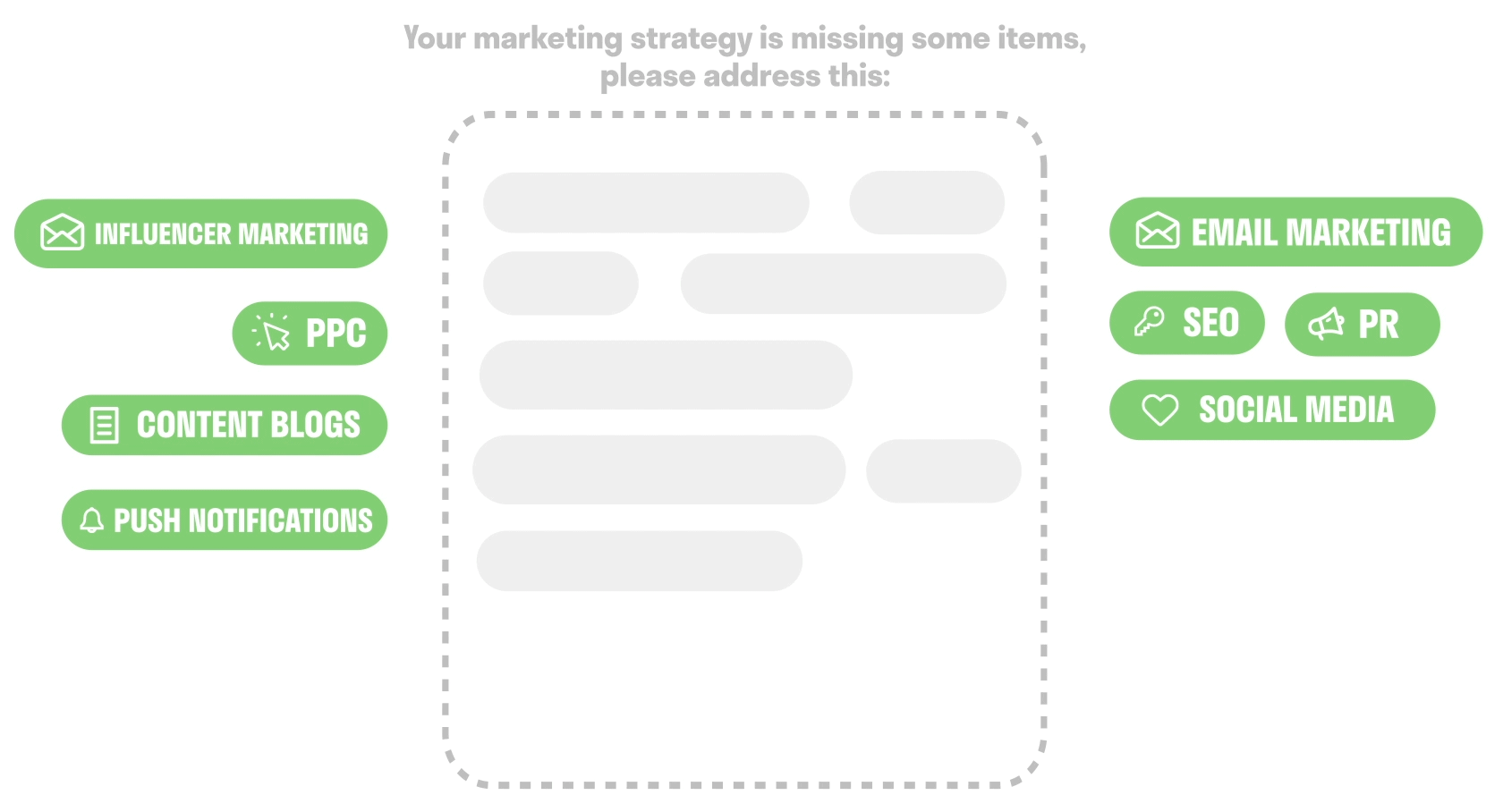
Once you have a solid marketing strategy in place that is repeatable, you can now also use it for scale. So in other words, you could share it with another employee, team, or division of the company. That way, the entire company is able to adopt the same marketing strategy for all of the products and services you offer. This will help to keep everyone on the same page and allow for consistency across all of your marketing campaigns.
Let’s go back to Penn’s Thanksgiving example one more time…
Imagine you were super busy on the run-up to Thanksgiving, and you hadn’t found a minute to properly plan out your holiday dinner, and so your neighbour shared theirs with you. This would be extremely helpful and save a lot of extra stress and time. Instead of having to focus on the why and what, you can now simply focus on the how. And if this menu was a success, then you might want to share it with your own friends and family. So this one menu is now helping many homes prepare great dinners.
Taking this back to your marketing strategy...
With an effective plan in place, that is both repeatable and scalable, you are free to focus your efforts on improving the strategy and making it work, rather than wasting a lot of time that you don’t have, worrying about what the strategy is going to be.
Before constructing a solid marketing strategy, it is vital to know exactly who you plan to target. Who your target audience is will impact many important decisions that you need to make, from branding and pricing, right through to the messaging you use, and marketing channels you choose to promote your products or services on.
Phillip Kotler
The more defined your target audience is, the better your marketing strategy will be as you’ll be able to create all of the brand marketing content, messaging, and ads with them in mind. As time goes on, and you gather more insight, you will continue to gain a deeper understanding of who exactly falls into your target audience. So don’t be afraid to learn as you go, and be adaptable to change, as you might find you need to go after a different group of customers to those you originally set out to reach.
And no, before you ask, your target audience simply cannot be everyone. Unless of course, you’re Amazon, who after 26 years of establishing themselves as e-commerce royalty, have earned the ability to target everyone and anyone they want.
Yes.
It can get pretty confusing when you see the terms ‘target audience’ and ‘target market’ being used interchangeably, and many marketers unknowingly assume that they are the same thing. Whilst sometimes they may be the same for your business, this is not always the case for others, so let’s quickly take a look at the differences.
The target market is essentially the general group of people who will use and consume the products or services you offer. These people may share demographic characteristics such as age, gender, income, and job. For example, the target market for nappies and baby wipes is babies and toddlers of all genders. Additionally, the target market for a luxury beauty salon might be women and men of a certain age, that come under a specific salary bracket and live in a particular location.
The target audience is whoever the business expects to purchase their product or service. If we use the earlier example of nappies, the product itself is aimed at the babies and toddlers but, of course, they aren’t going to be the ones making the actual purchase. In this circumstance, the advertising and marketing efforts should be directed at the target audience, which is made up of the parents and guardians making the purchase.
Your target audience can also be a subset of your target market; these are people you are trying to reach as part of a particular marketing communication or promotion. For example, a luxury beauty salon might be offering discounts off a number of anti-wrinkle treatments. As these treatments are generally age-specific, there is no need to target your entire market. Instead, your target audience can be made up of those who are within the right age bracket.
Related reading: Top Tips to Identify Your Ideal Target Audience
Having a defined target audience is a vital element of your marketing strategy. It enables marketers to:
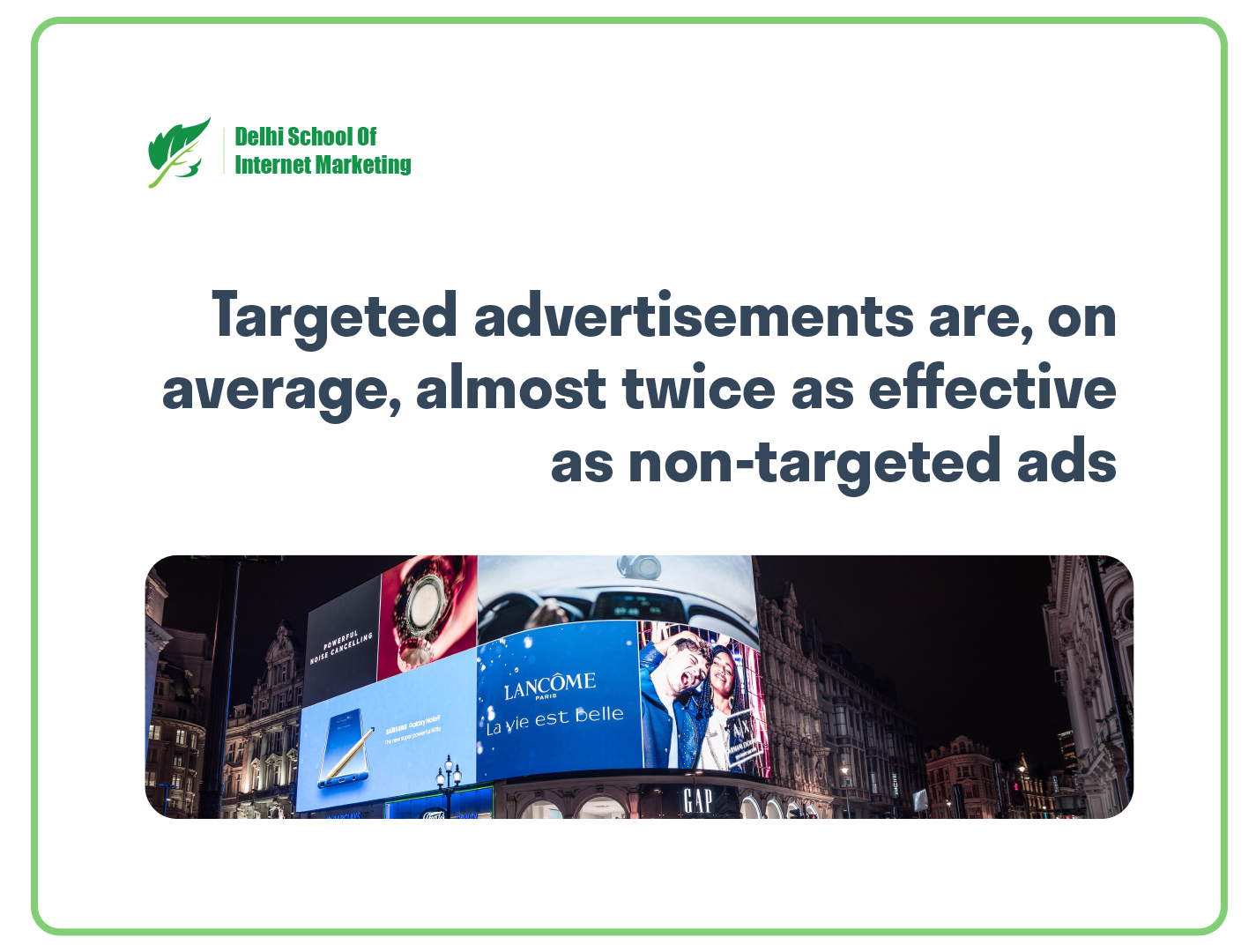
Being able to relate to the tone and content of a message is necessary in order for people to ‘buy into’ your brand. This ability to strike a chord with your customer allows you to make a personal connection and establish trust. By targeting consumers who are highly likely to have an interest in your brand, product, or service, you are more likely to see a higher return on investment (ROI), in comparison to sending out a direct mail to every possible household.
Once you have established your general target market, it’s time to segment. Customer segments are made up of a number of subgroups of your overall audience, often defined by their similar needs and wants. Consumers have become much more empowered and expect highly personalised messaging from brands, meaning that segmentation is now more crucial than ever.
For most companies, there are various types of customers that might have an interest in the products or services you offer. The process of segmentation involves identifying these different groups and effectively positioning your brand to each one.
So let’s briefly discuss some of the most common methods used by marketers to segment their target audience:
Demographic segmentation is one of the more basic methods and involves grouping consumers based on factors such as age, gender, marital status, education, religion, race, income, occupation, and family size. This data is one of the easiest and quickest for brands to collect and analyse, so it’s no real shock that most companies successfully segment their customers using (at least) demographic information.
Geographic segmentation involves the division of your target market based on their country, region, or state. In certain scenarios, for smaller companies, it can even be beneficial to drill this down further to the city, neighborhood, and zip code. But it doesn’t just focus on the ‘where’ of your customer. Geographic data factors in the urbancity, climate, culture, and language of your target audience, all of which can have a great impact on your marketing strategy.
Behavioural segmentation involves dividing your audience based on the information you have gathered during their past interactions with your brand, be it online on your website and within your app, or how they behave in-store. Having this insight gives your company the advantage of knowing when, why, and how to optimise your customer’s experience. Any findings and decisions you make as a result are based on real data, rather than something presumed.
Psychographic segmentation focuses on your target audience’s personality traits, values, interests, lifestyle choices, opinions, and motivations. This sort of data is often collected via focus groups, surveys, interviews, and case studies. Understanding the incredibly different needs and wants of each sub-group, and being able to apply this knowledge to your marketing campaigns is the key to achieving higher conversion rates.
As a marketer, when you are equipped with an in-depth understanding of each of your customer segments, you will be able to set objectives and form ideas centered around your audience. This will ensure that you create only the most highly personalised campaigns that will achieve maximum impact. Your customer segmentation should underpin every part of your company’s marketing strategy.
While we’re on the topic of customer segmentation, it makes sense to touch on the sales funnel. Sometimes referred to as the marketing funnel or the buyer’s journey, the sales funnel is essentially the path taken by a potential consumer that leads them to the purchase of your product or service. The idea is that marketers ‘cast out their nets’ and draw as many leads as possible into the funnel. They will then slowly nurture each of these leads through the different stages and ultimately end up converting some of them into customers. In an ideal world, the funnel would be more of a cylinder, resulting in every lead converting into a customer. But of course, in the harsh world of marketing and sales, this is never the case - hence the narrowing funnel.
Having a well thought out sales funnel should be a high priority for marketers. It provides great insight into the thought process, challenges, and decisions that are being made by your potential customers. As well as that, your communication with each consumer should be very different based on their stage in your sales funnel. So it has a huge impact on your marketing content too.
Related content: How to Delight Your Customers at Each Stage of The Buyer's Journey
Having an understanding of your sales funnel will also highlight the points at which your target audience are dropping out and failing to convert. This valuable information will allow you to put a plan in place that helps prevent potential losses.
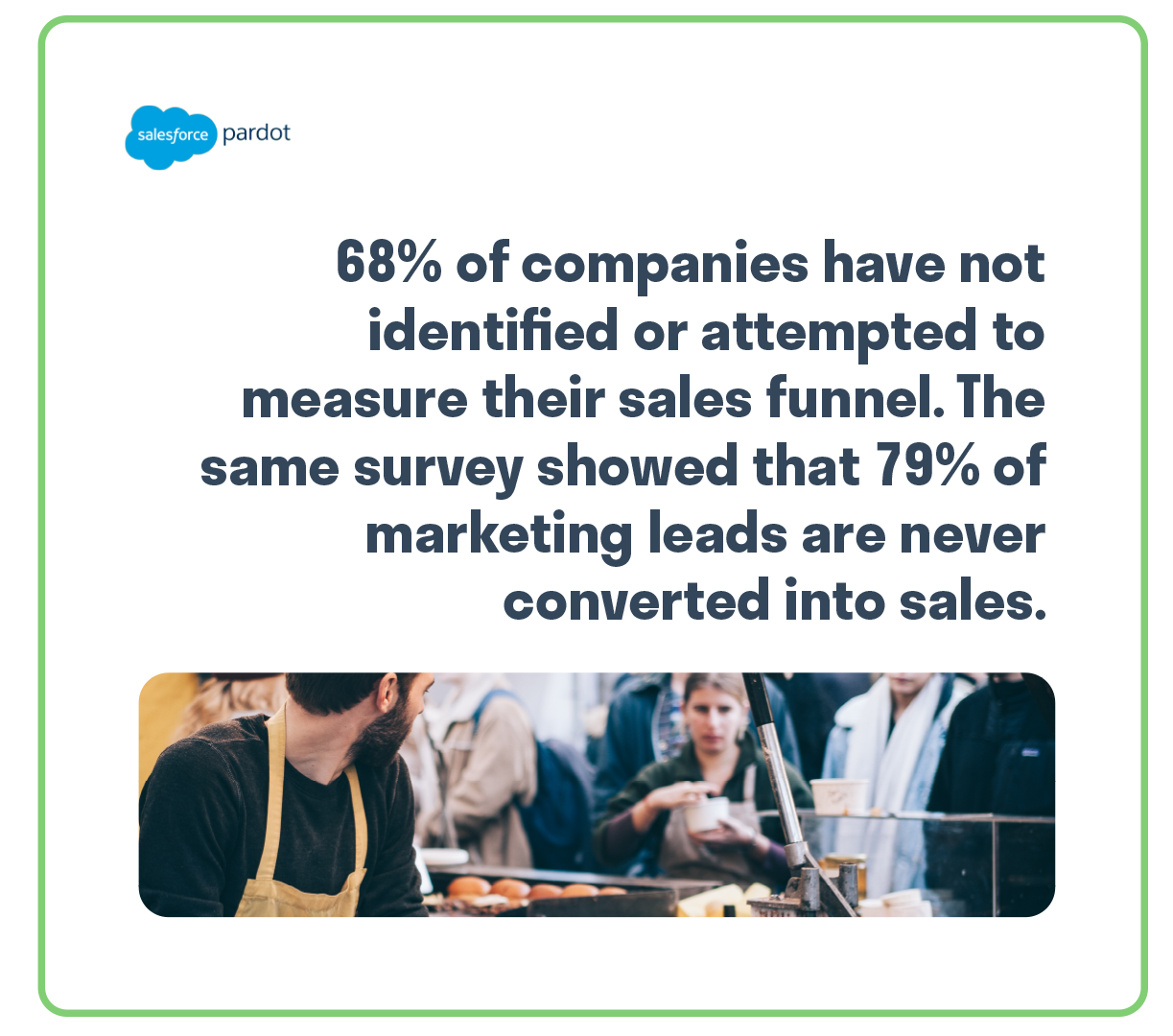
Each stage of the customer journey requires a different approach from the marketer if they want to move customers smoothly down the funnel. The last thing you want to do is send someone the wrong message at the wrong time.
It’s important to note that the sales funnel or buyer’s journey is not a one-size-fits-all model. It varies a lot from brand to brand and there is not a single agreed-upon version of the funnel. Some have more stages than others and give each stage a different name, but the overall idea remains the same. And that overarching idea is to provide your audience with marketing content that is timely, targeted, and relevant.
So, with that in mind, let’s take a look at a typical five-stage experience that your customer might take with your brand. From the initial awareness stage to becoming a loyal, paying customer:
At this very first stage, it is likely that your target audience has never heard of your company before, or of the products or services you offer. This is the point where your prospective customers are realising they have a problem and educating themselves around it through research. It’s common for people to take to a search engine like Google at this initial stage, and find themselves typing various things into the search bar in order to find help. Check out these examples below and see how they could be applied to each of the indicated businesses:
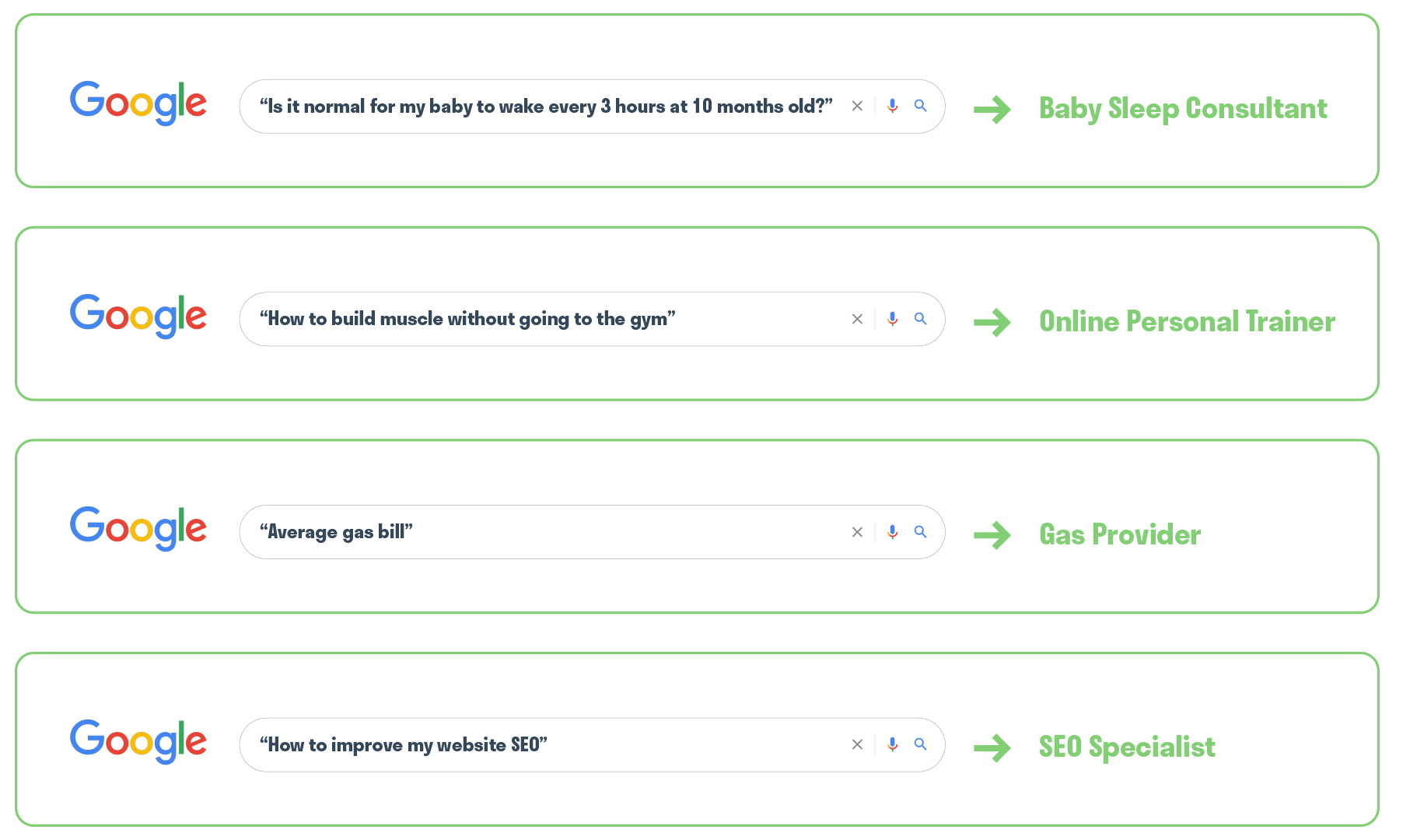
As a marketer, you need to ensure that you have helpful, relevant content that ranks highly for the particular keywords and phrases your prospect might be searching for at this fundamental stage.
As well as from Google Search, you can also generate leads using other forms of awareness, be it a tweet, promoted Facebook or LinkedIn post, trade shows, advertising, webinars, PR, or whatever methods work best for you and your business.
Depending on the type of product or service, what background research your consumer has done, as well as how good your content is, this initial stage of awareness can result in a purchase right away.
But for most, the journey continues…
At this stage of your customer’s journey they have figured out exactly what it is that is bothering them and want to know all the possible solutions. They know that your product or service is an option, but your prospect needs to do further research and compare prices and suitability.
Communications with your target audience at this point need to be as helpful and informative as possible. Avoid being too sales-y as this will only add pressure and drive them away. You want to highlight the key differentiator of your product/service over your competitors and help them to make an informed decision. Case studies, pricing guides, comparison-style checklists, and webinars are all examples of key pieces of content that we marketers should be providing at this consideration stage.
Once your prospect has reached the decision stage they are almost ready to buy; they have narrowed down their options to around 2 or 3, including you, hopefully! Consumers will bring together all their research and decide which option offers the best solution to their problem, at the best value for money.
Content at this stage of the sales funnel exists to reinforce your prospect’s confidence in your product or service. You’ve got them this far, so they already think you’re a pretty good option, but now you need to convince them that you are the best option.
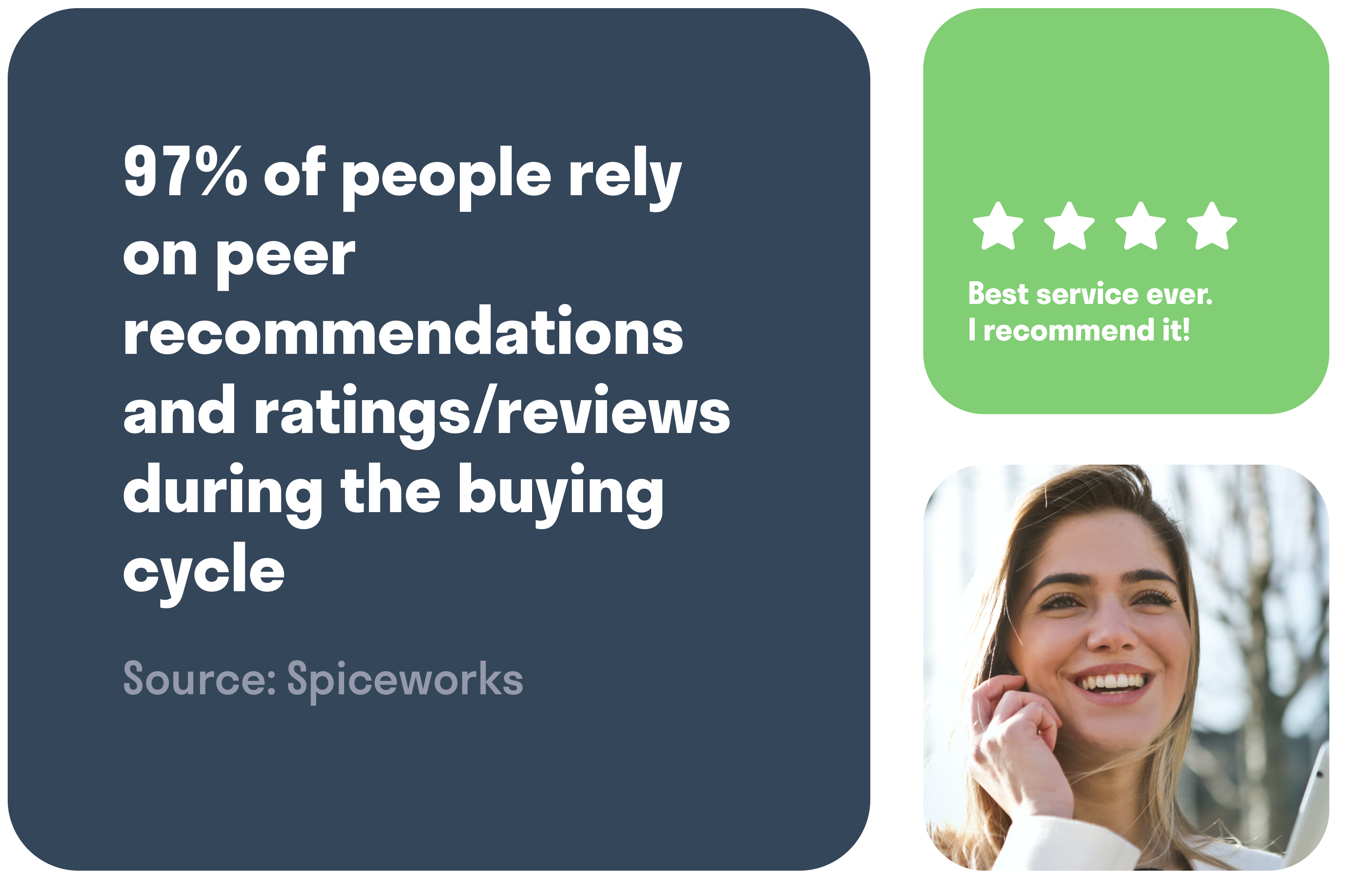
Customer reviews and testimonials are hugely effective at this stage of the sales funnel, along with FAQs, product demos, a free trial, competitor comparisons and even a discount code.
Once your prospect reaches the retention stage, they have officially purchased from you and you have succeeded in turning them into a customer. But the journey doesn’t end here. As a marketer, you need to be thinking about how you can turn this one-time purchase into 10, or this monthly subscription into an annual one - whatever defines customer loyalty for your business.
It’s a well-known fact that retaining a current customer costs a company less than acquiring a new one. For most businesses, it’s about the quality of your customers, not the quantity. Loyal, returning customers are where you will make the most profits.
At this stage, you want to start strengthening the relationship by helping your customers to get the most out of the product or service they purchased from you. Follow up calls or emails to thank them for their purchase and ask for feedback is a great way to show you care, as well as deal with any issues that may have come up.
If your product or service requires some form of set up, then having an effective onboarding process in place to guide consumers through these steps, will also help to keep your customers happy.
The advocacy stage is all about turning your now loyal customers into active advocates for your brand, product or service.
This stage occurs when your customers become more than just your customers; they are now also your fans. This means that not only will they continue to purchase from you time after time, but they will also tell their closest friends and family about you whenever they get a chance. Be that in person or online via social media platforms or review sites.
People trust other people, making word of mouth (WOM) one of the most powerful forms of marketing - and the best part? It costs you absolutely nothing! To help encourage this behaviour it’s important to continue showing your most loyal customers just how much you appreciate them. Be sure that any communications you have with them are super personalised. You could even offer them discounts or other incentives in return for customer reviews, testimonials, and friend referrals.
Customers at the advocacy stage are also more likely to provide you with their honest feedback. They believe in you just as much as you believe in yourself so be sure to utilise this! Use tools like SurveyMonkey to send out an email in an attempt to gather as much constructive criticism as you can. The more insight you have from your current customers, the better experience you’ll be able to provide for them and future customers.
When it comes to planning your marketing strategy, a good place to start is with your goals and objectives. Because, without them, how are you meant to know if your marketing efforts have succeeded or not?
The SMART method is a commonly used framework in marketing for successfully setting goals and objectives. It stands for Specific, Measurable, Achievable, Relevant and Time-bound.
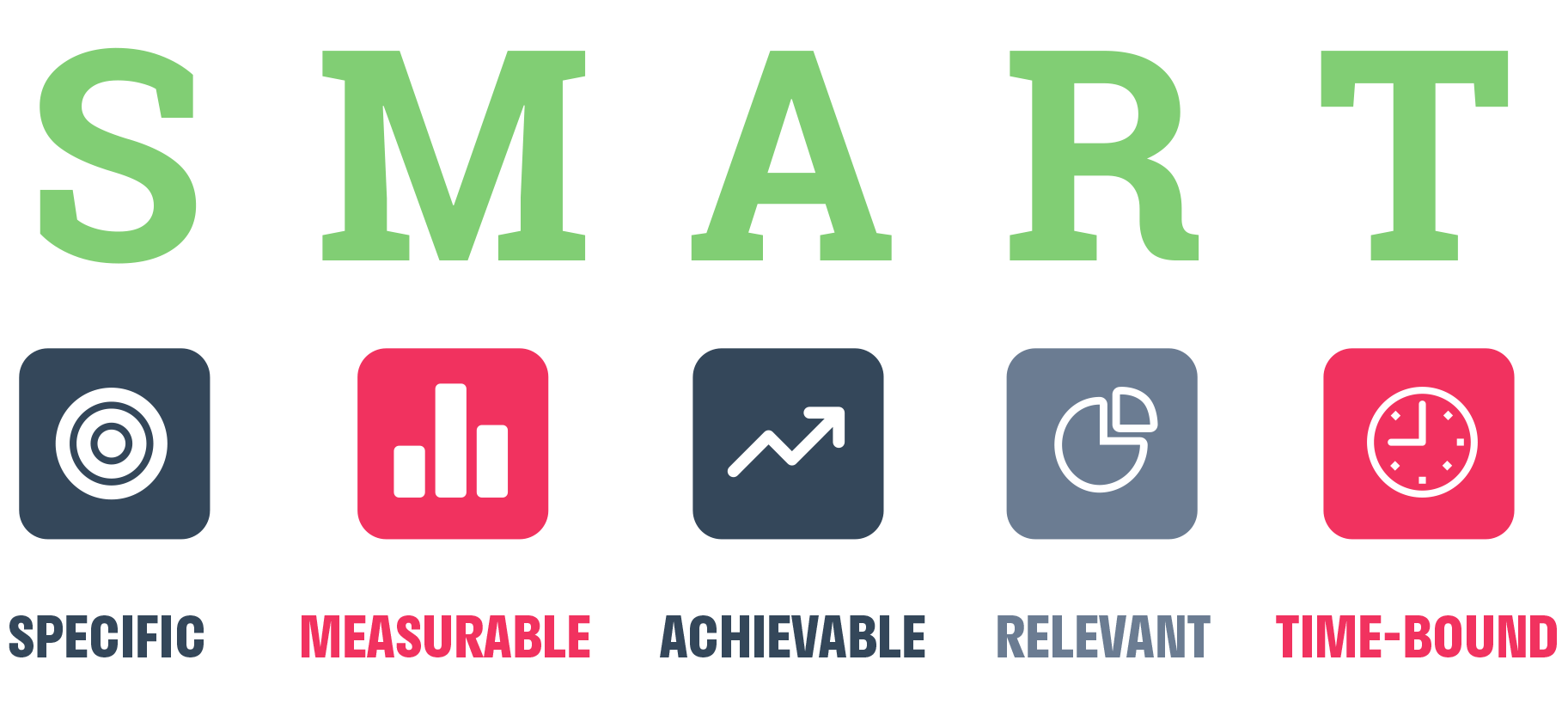
Ideally, you want to set goals for your strategy that are ambitious, and force you to put in the work, but you need them to be achievable at the same time. There is nothing more demotivating than working towards a goal that you and your team know is impossible to reach.
So let’s take a look into each of the five objectives in the SMART method, and how they can help you set practical goals.
Try to be as specific as possible when creating your goals and focus only on one clearly defined metric. Generally speaking, those who set vague and ambiguous goals are less likely to achieve them. With focused marketing objectives you can help to eliminate distractions and make your end goals clearly visible.
It is completely necessary to have some form of system in place that allows you to measure results. In the past, marketing was very much a guessing game. However, nowadays we have hundreds of tools available to gather, analyse and report back on the data. So make sure you know exactly how you’re going to get your hands on the data you need and how you’re going to analyse it.
Related content: [Infographic] Explain The 3 V's of Big Data
The most effective goals are those that are challenging, but still achievable. Don’t just set goals based on what you think your boss wants to hear. That will only make you sound great until you have to report back that you didn’t even come close to achieving this goal. Failing to hit your targets is very demotivating for both you and your team, so don’t make life harder than it needs to be. Of course, this doesn’t mean you should set easy goals either, you still need to be constantly challenging yourself and pushing the boundaries, so try to find the middle ground.
Related reading: 10 Effective Marketing Strategies for Business Growth
The key to setting relevant goals is making sure the objective aligns with the overall strategic positioning of the brand. In other words, the goal needs to accomplish something that is going to boost business or enhance your brand's relationship with its customers.
For example, you might set a goal to build a huge following on the latest up-and-coming social platform, TikTok, with the aim of drawing new leads and increasing your ROI by 3%. So you put all the tactics in place to do so and, hey presto, this ends up being pretty successful and you are now the proud owner of a TikTok account with 1000 followers.
But then you remember that you are a B2B business that sells office space in North America, and the audience you have acquired on TikTok is completely irrelevant to your company’s overall strategy. So despite the fact that you have partly achieved your goal by building a large following, you have not gained any valuable leads, which means increasing your ROI by any amount via this platform is irrelevant to your company.
Every goal must have an end date for when you expect to have achieved that metric. Getting the timing right is crucial to the success of the goal. You need to make sure you have given yourself enough time, otherwise, you will be writing your marketing efforts off as a failure before you have even given them a chance.
With no time limit in place, how will you know when it is the right time to call the strategy a failure or a success? Without deadlines, we tend to lose focus and can easily get distracted by other tasks that seem more urgent. Open-ended objectives have a habit of never being completed, so making sure your goals are time-bound will allow them to be more achievable. Having a deadline will also enable you to track your efforts and reflect on the overall process once you reach your goals.
When planning your marketing strategy it’s important to take a number of external factors into consideration. One of the most commonly used analytical tools for assessing such factors is the PEST Analysis.
PEST is an acronym that stands for Political, Economic, Social, and Technological (analysis). PEST analysis is used to assess these four external factors in relation to your own company.
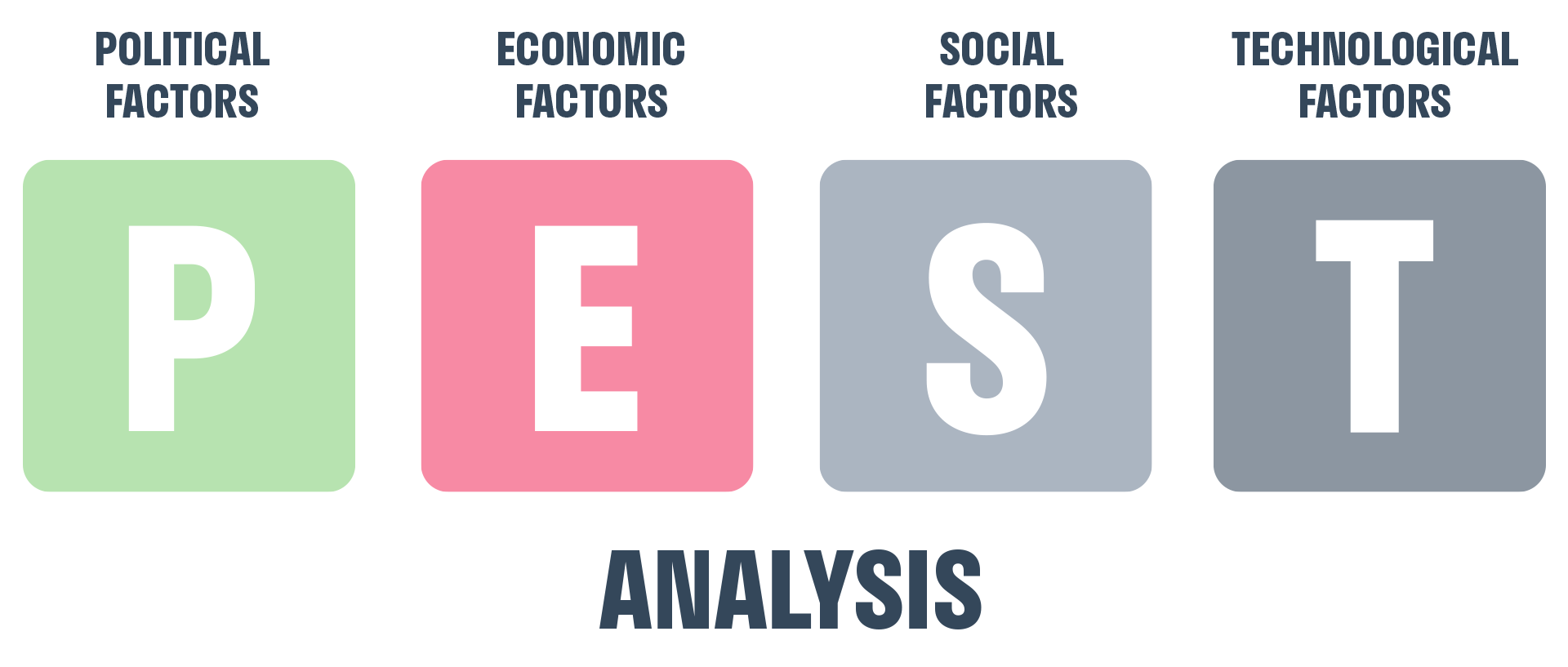
In order for your marketing strategy to run smoothly and be as successful as possible, it is vital to understand any opportunities and/or threats in both the current market and the wider environment. Carrying out a thorough PEST analysis will enable you to better understand the market trends and conditions, as well as helping to identify the expected constraints on your strategy.
Let’s take a look at each of the four factors to gain a better understanding…
Tax policies, employment laws, tariff & trade restrictions, consumer protection laws, environmental regulations, copyright, advertising regulations, political stability of a country, etc.
This is an analysis of how politics is affecting the business world. There can be many different government regulations that will either go in your company’s favour, or they won’t and, besides, political factors will likely be out of your control anyway.
The best thing you can do is to make yourself aware of anything that could impact your marketing performance and adhere to the rules to avoid any major penalties or backlash.
Economic growth indicators, inflation rate, interest rates, exchange rates, fiscal policies, unemployment trends, etc.
Understanding the current economic climate is important for marketers in order to have a better grasp of the factors that affect consumer buying power. These factors have a direct impact on how much money people have to spend, as well as the cost of your products or services. By factoring in the economics of your target market when developing your marketing strategy, you can be prepared for any ramifications as a result of an economic downturn.
Cultural aspects, age distribution, career attitudes, health consciousness, population growth rate, social classes, etc.
The social environment of a business consists of all that a society believes; its customs, its practices, and the way it behaves. By digging deeper into the social factors surrounding your target audience, a business can learn how a consumer's needs are shaped and what brings them to the market to make a purchase. This knowledge is hugely important when constructing a marketing strategy as it will enable you to pinpoint purchase motivations which you could then incorporate into your campaigns.
Rate of technological change, technology incentives, spending on research & development, basic infrastructure level, etc.
Technology can have a huge impact on businesses on so many levels and can either be an addition that is welcomed or shunned. When developing your marketing strategy, it’s important to be aware and keep up-to-date with all the latest technological advancements that might improve your operations and add value to your customers.
If you fail to do this, then it’s likely that your competitors will already be utilising this technology and providing a better customer experience than you are.
Of course, it’s also important to be aware of the business transformational phase when adopting any new technologies as this can often take time to get to grips with.
Often marketers will extend the PEST analysis to become the ‘PESTEL’ analysis, incorporating two further factors; ‘Environmental’ and ‘Legal’.
Climate change, waste disposal, pollution, carbon footprint, CSR (Corporate Sustainability Responsibility), etc.
Environmental factors are more dominant now than they have ever been. Peoples’ awareness is heightened and they’re more educated on environmental matters and the impact that global production and trade can have on the wider environment. Thanks to things like social media and alternative news sources, people are connected more intricately, which means that information is much more advanced and available to concerned consumers.
Consumer awareness of environmental factors means that brands globally have to factor in elements such as sustainability, waste management, recycling procedures, etc, of their production and distribution, which ultimately impacts various aspects of their marketing strategies
Employment legislation, health and safety, trade regulations and restrictions, discrimination laws, etc.
Although legal factors often overlap with political factors, the law remains an important aspect of any business in order to facilitate successful and ethical trade. Trading internationally can bring about issues as many countries have their own sets of rules and regulations, however, many countries abide by the same or similar legal regulations. By not considering legal factors when creating your marketing strategy, you run the risk of harming, or even destroying, the entire brand.
A SWOT Analysis is a simple, yet powerful, technique used by businesses globally in order to assess and adjust their current position before finalising their strategy.
SWOT stands for Strengths, Weaknesses, Opportunities, and Threats. This established method of analysis is the primary way that businesses position themselves and determine how aligned they are with their vision, goals, growth trajectories, and success benchmarks. Your strengths and weaknesses refer to the internal aspects of your business, which are essentially the things you have control over. Whereas opportunities and threats are generally external elements that you cannot control, like the actions of your competitors or the condition of the wider market. A SWOT analysis can be used for any number of different things such as a marketing project, a sales campaign, a new business case, or even revamping your brand.
Related reading: 4 Tips for Creating a Successful SWOT Analysis
SWOT analysis offers business insights that focus on both internal and external impacting factors. Conducting this type of analysis heightens your chances of success and reduces the likelihood of failure.
So, whether you’re a small tech startup or a Fortune 500 company, SWOT analysis is there to help.
Let’s dive a little deeper into each aspect of the SWOT analysis to understand how each element can benefit you.
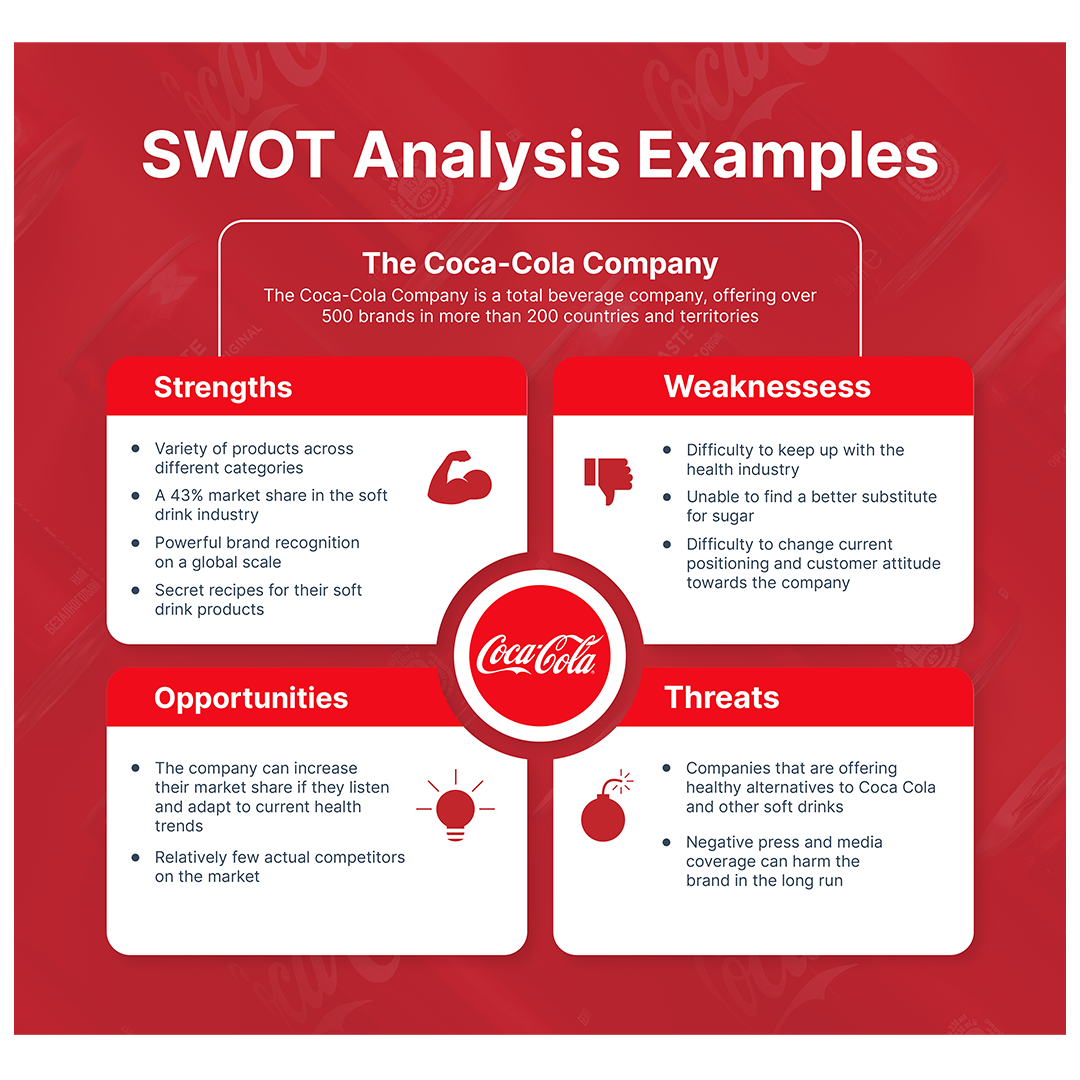
Your strengths are the areas that your company excels in; things that you do especially well. Think of your assets, processes, people, communications, content, values, etc. It’s what makes you unique, it’s what makes you thrive, it’s the things that give you an edge over your competitors.
Some strengths are clear to see; if you have a huge following on social media, chances are that you’re doing something right. But do you have a multitude of followers because people love your brand or your product, or is it because you post really funny tweets? It can sometimes be tough to precisely pinpoint your strengths. Asking questions like these will shed some light on the areas where your business really excels, and why:
Defining your strengths shows you and your team what you’re really good at; where you surpass others; why you deserve your place in the market and continued success. A confident brand means that consumers will see you as strong and trustworthy, meaning that you will likely gain their continued custom. This powerful, self-assured brand personality not only helps to retain current customers but also draws in new ones. When your business is healthy and capable, it strengthens and validates the reasons why your employees work for you, and why your customers made the right decision to do business with you.
At the end of the day, people don’t want to do business with a brand that seems to be powerless or ineffective; it loses a sense of trust that both employees and customers need. When you harness your strengths, have happy employees, and loyal customers, you will accomplish positive word of mouth (WOM), which is essentially free, reliable marketing!
Weaknesses refer to the ways in which your company is lacking; factors that are holding the business back, or stifling a project, for example. Essentially, weaknesses are what stands in the way of you reaching your full potential. Some weaknesses are out of your control which is unfortunate, but some are easily fixed. When it comes to brand success, there are usually ways in which you can turn weaknesses into strengths, or at least address and fix the weakness so it’s no longer a factor that lets your competitors gain an advantage over you.
Similar to strengths, it’s not always easy to identify your weaknesses. Your business may be going downhill and perhaps there’s no obvious reason why. That’s why you need to ask yourself these critical questions and shed some light on the elusive issues that are holding you back:
Examining your weaknesses helps you to move that extra step closer to success. Think, hypothetically… your company isn’t doing badly; your profits are steady and you have a healthy team of employees, but you don’t seem to have loyal, returning customers. You conduct a SWOT analysis and something shows up as a solid weakness; you have been receiving negative reviews online. You examine these reviews further and realise that you don’t have a post-purchase care strategy in place. This means that customers are purchasing your products just once and then leaving. And any questions, queries, or complaints that they have remain unanswered, sigh, that’s no good.
Your SWOT analysis has given you the insight that you need in order to add another level to your organisation in terms of legitimate, meaningful, customer care. Just imagine how much stronger your business could be at this point if you had actioned a thorough SWOT analysis that identified your weakness earlier on. Conducting a SWOT analysis alleviates potential blunders and tackles your pain points head-on, offering internal insights that continuously strengthen the brand and advantage your strategies.
According to Mirriam-Webster, an opportunity is defined as:
Opportunities can come from any angle. They could materialise from within your company; for example, you might have recently gained a strong, growing presence on social media. This growth would give you the opportunity for greater outreach and an active platform for you to develop lasting, genuine relationships, in turn, developing a loyal audience base. Or they could be external factors, such as new trends that relate heavily to your product or service which, of course, you can likely capitalise on.
First, in order to identify any potential opportunities, you should address these questions:
Identifying and actioning any opportunities that come up for your business, whether they’re internal or external factors, big or small, is integral to the long term development of the brand. Steady growth is great, but without significant growth and positive progress, you run the risk of being left behind, or of your competitors taking that great opportunity that you missed.
SWOT analysis gives you the ability to capitalise on current or upcoming opportunities that you may have otherwise missed. These opportunities could be anything from improving sales, adding an extra, vital element to a campaign, or advancing your company’s long-term goals.
Threats include anything that can negatively impact your business. They tend to be external factors such as a changing market or emerging competition. Consider any obstacles that may get in the way of you bringing a product to market, selling, or generally achieving your business goals.
As threats, more often than not, are external factors that you can merely influence or prevent rather than control, it can be difficult to truly identify them. Of course, it’s important to conduct a thorough competitive analysis, as well as internal auditing. But to help you discover any threat that you face or could potentially face in the future, consider these questions:
Investigating potential threats is a fundamental aspect of brand success. Imagine you are a small-to-medium-sized enterprise (SME) that sells furniture at an average price, think middle of the range, you occupy a substantial chunk of the market and a new competitor enters the scene. In order to avoid any negative impacts at the hands of this new brand, you need to identify any threats they may impose on you so that you can alter your behaviour, your business model, your communication practices, or your campaigns in order to stay at the top of your game and maintain your loyal customers.
Threats are a vital factor for your business to examine because they can appear out of nowhere, particularly with the rapidity of modern social changes, the saturation of markets and increased technologies; threats in almost any market are entirely plausible and can happen instantaneously. You need to be prepared, in advance, so that when threats do arise, you already know how to tackle them and continue to reign supreme!
Carrying out a competitor analysis for your business is the equivalent of a football team sizing up the other side before a big match. You want to figure out exactly what tricks your competition has up their sleeve so that you’re not blindsided when you come head-to-head.
Related reading: 10 Competitor Analysis Tools You Need In Your Marketing Stack
Competitor analysis is a strategic method of determining any current or future threats posed by other companies to the prosperity of your business. This analysis considers multiple factors in an attempt to highlight the strengths and weaknesses of a potential competitor and how these compare to your own businesses.
When defining your company’s competitors, you must consider a number of key dimensions, however, you should always start with:
After this step, companies who have been identified as similar to your business in one or both of these areas can be split into two main categories:
These are companies that meet the same set of customer needs as those you are targeting.
The customer segments that your direct competitors serve are the exact same as yours; their products are manufactured just like yours, serving the same functions, and they aim to market their products using (you guessed it) the exact same channels as you.
For example, if you were the owner of McDonald’s then one of your direct competitors would be Burger King.
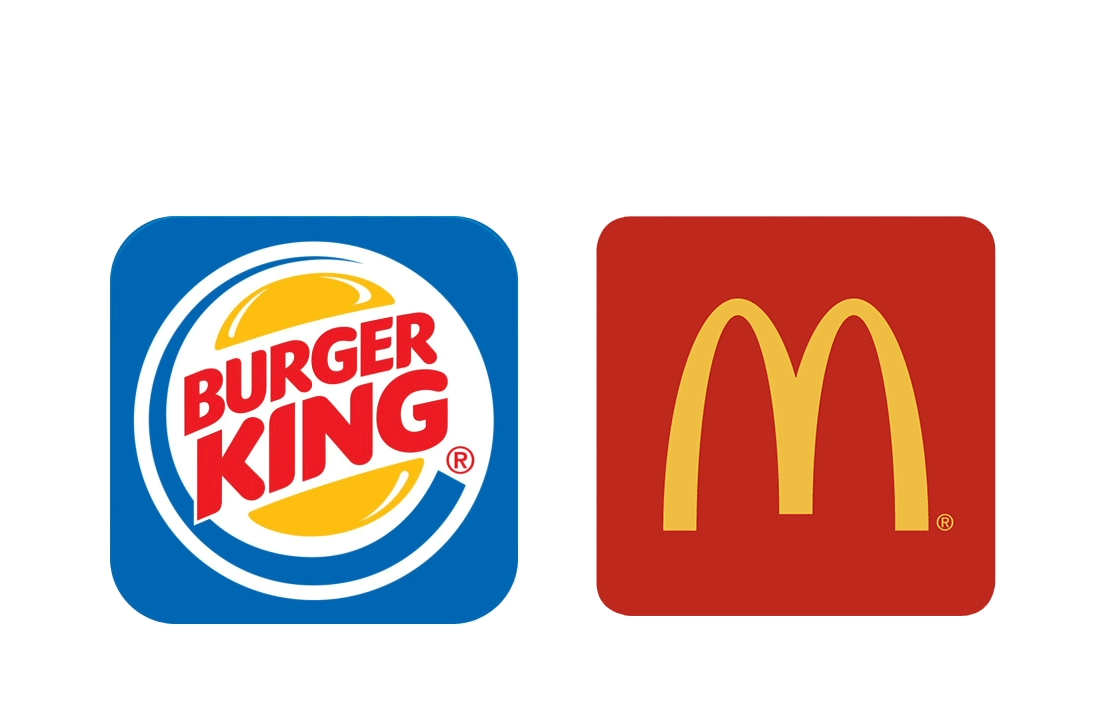
Just when you thought you had enough on your plate, in walk your indirect competitors. These are companies whose products or services are not the same as yours, but they are targeting the same segments of the population and satisfy the same need as yours.
For example, if you were the owner of Pizza Hut then one of your indirect competitors is Subway.
Oftentimes, your indirect competitor’s products or services can even be contradictory to your own. The fast-food industry is indirectly in competition with the diet industry. So, if you are the owner of Pizza Hut, you will also need to monitor Slimming World’s business models to ensure they do not steal away your customers. This is why we often see fast-food chains offering healthier alternatives.
There are plenty of reasons to carry out a competitor analysis, but number 1 is to ensure that your chosen strategy is strong enough and differentiated enough to beat your competitors. The only way you can be sure of this is if you know how to think like your competitors, how to predict their next move, and top it in your campaigns.
A thorough competitor analysis will give you a keen understanding of the marketplace where you do business, what it takes to succeed in that marketplace, and what actions can lead to failure.
Economically, you will benefit from a clearer pricing structure and an ability to predict market trends, product development possibilities, and develop an understanding of what your customers will be faced with when making their purchasing decisions.
To be on top, you need to be one step ahead of your competition; a competitive analysis will not only help you to understand your current competitors but will also give you the foresight to spot any future competition and adjust your strategy before they become a problem.
There are many different ways to carry out a competitor analysis. But at the end of the day, you will get out of your competitor analysis what you put into it.
Lightly skim the top and you won’t have enough insightful data to action anything useful. Similarly, if you go too deep it’s likely you will be overwhelmed with data and be left unsure of what is important to your strategy.
There are a few things that you should always do before you get stuck in:
Smart insights suggest using the RACE acronym to help you stay on track and cover all your bases when completing a competitor analysis. Each letter of the acronym indicates a broad area of analysis where you should focus your attention:
To begin your analysis, you should be considering all of the avenues from which your competitor draws in traffic or, in other words, their reach.
You will want to consider a number of elements here, from digital aspects like website traffic, backlink profiles, and social media following, to physical presence such as the number of stores and accessibility of these locations. Assess which channels your competitors are using which you may be missing out on, and employ digital tools to fully visualise their reach.
The reach of your competitor’s sales team is also an important factor. Do they have multiple store locations? Do they gather leads using inbound tactics or employ lead generation tools for cold outreach, or both? Analysing both the geographic location and digital presence of their sales process will be vital to understanding how your competitors penetrate the global marketplace.
How do your competitor’s offerings force customers to act? Here we must consider the key customer journeys that potential audience members will go on when interacting with your competitors’ brand.
Consider the presence of key touch-points such as landing pages, pop-ups, banners, and offerings used for lead generation. Ask yourself which audience segments these methods appeal to and how the content offered will motivate consumers to act.
Is content used to drive potential customers through the buyer’s journey? If so, what kind of content is used and what quality is it? Does your competitor have a lot of content published or very little? How often do they post to their blog? How long and informative are their blog articles? What is their tone of voice and is their spelling and grammar an issue? These are the sorts of questions you must ask yourself when performing a content audit of your competitor’s resources.
What barriers and pathways to conversion exist within your competitor’s repertoire? To understand what we mean by barriers, we must consider the experience of first-time website visitors; are they required to ‘sign-up’ before browsing or making a purchase? If a sign-up is required, is it a simple process with social integrations (Facebook, Gmail, etc.) or are there multiple, mandatory fields placed between the customers and conversion?
How well is the value proposition of your competitor’s products communicated across their channels? Is communication consistent and persuasive or fragmented and sales-y? Communication is a key part of the conversion process.
Website usability and user experience will be huge factors in this section of your analysis. How does your competitor layout their products - are they separated by function, target segment, pricing, or are they unfiltered, causing complicated breadcrumb trails? Whether the customer can easily navigate your competitor’s resources and successfully process through their checkout is vital knowledge. And what if they don’t complete the purchase? Understanding how your competitors salvage abandoned carts, or whether they don’t bother at all, is key to your competitive advantage.
Related reading: How to Build the Perfect Shopping Cart Abandonment Campaign
What methods do your competitors use to engage their potential customers? Do they use blogs, guides, white papers, webinars, e-books, templates, etc? Personalisation is a key indicator of engaging content, so be sure to consider what elements your competitors' content has been personalised to meet their audience’s needs (if they have, in fact, personalised at all).
Does your competitor use email marketing as an engaging tool? If so, how often do they email their contacts, and do they use segmentation to divide their lists for a more engaging experience, or do they send mass-email blasts? How do their sales teams use email to engage leads - are they effective or annoying when it comes to trying to connect?
What level of engagement does your competitor receive back from their followers on social media? Do their posts feature many likes, shares, and comments? If there are comments, are they positive or negative, and does your competitor respond to these comments promptly? Incorporating social listening practices into your analysis can help you find out where and how your competitor is being talked about by consumers online - and you can use that to your advantage.
Related content: [Infographic] 4 Stepping Stones to a Successful Competitor Analysis
Create a spreadsheet that will act as a competitor analysis template. Date it, and reuse the template each time you run this analysis. This allows for making easy comparisons over time and will show you changes within your competitor’s approach.
Many tools exist that will allow you to instantly access data about your competitor in many different areas of their operation. For example, Mention for social listening, Similarweb for traffic, Mailcharts for email marketing, Buzzsumo for content auditing, and Alexa for SEO and keywords analysis, etc.
Tools are great but we must give an honourable mention to the old fashioned way of doing things...
By carrying out any, or all, of these activities you will get to see exactly what their customers see, thus, removing all guesswork.
Too many fields, too much research, nit-picking, etc. - decipher the most important details for your company and stick to them.
Budgeting… it can be super boring, right? But often budgeting only seems like a drag because we don’t really understand it. This is certainly true when it comes to marketing. You might find yourself wondering what it is exactly that you’re budgeting for, or how much you should spend, or the timeframe you should look at.
Well, try not to worry. It can be simple if you look at it like this…
Your marketing budget gives you a clear overview of all of the costs associated with your marketing activities, including their execution. A marketing budget is essential for businesses both large and small, and typically includes elements such as:
Whilst that’s a lot of elements to factor in, they make up the types of marketing activities that you need to budget for.
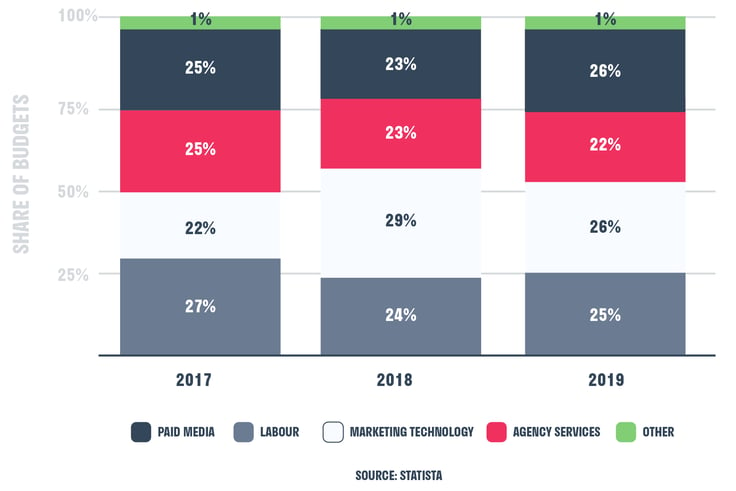
Your marketing budget acts as a detailed roadmap that outlines the cost of all marketing actions and tactics that are involved in your strategy, i.e. the cost of everything involved in achieving your goals.
It’s tough to know how much money to allocate to your marketing strategy, and that’s because every business is different. A marketing strategy budget will be totally different for large companies vs. small businesses; for digital brands vs. brick-and-mortar stores, for the tech industry vs. fashion, etc.
 Source: Brafton
Source: Brafton
Overall your marketing budget depends on factors such as:
A marketing budget is based on the predicted cost of your activities, campaigns, and tactical plans that will help you to achieve your business ambitions.
As marketing is becoming more and more integral to the success of a company, it’s more than likely that we will see an increase in budgeting. The CMO Survey has spent 10 consecutive years collecting data on the marketing spend of top marketers and how this was expected to change.
According to the 2020 survey, domestic marketing spend has risen by 13% since 2012 and is expected to grow by 7.6% in the next year.
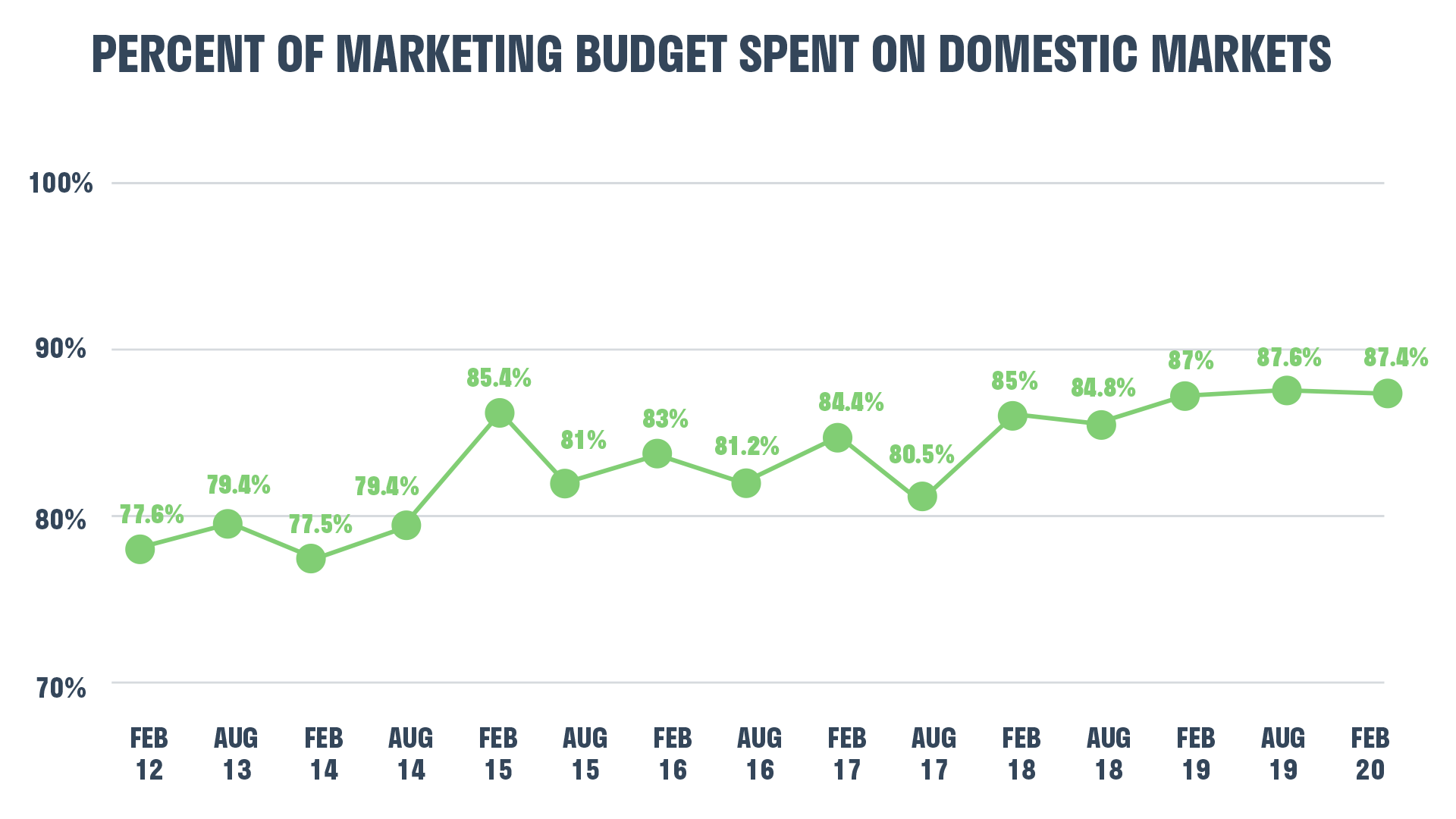
Source: CMO
CMO also reports that B2B Services companies are most likely to spend domestically, noting that 92.7% of their marketing budgets are devoted to domestic markets. This is compared with B2B Product businesses, which report to spending 79.8% in domestic markets.
In 2019, IAB UK reported that spend on digital advertising has increased, with spending on display ads up 13% year-on-year.

Source: IAB UK
This really comes as no surprise: as markets become more saturated, businesses have to do more to reach their target markets. And in order to communicate their prestige over their competitors, their marketing strategies must be on point. That means accurate targeting and meticulous, clever budgeting.
Marketers also need to break through the noise of other ads, which involves either spending more or spending differently. Either way, this generally means increasing the marketing budget to allow for new and creative ways to communicate with a business’s prized audience.
No business can realistically survive, long term, without a budget. It’s set in place so that you know what you’re spending, where, when, and why. Imagine spending all of your money in one sitting on the likes of television advertising - and then realising that most of your target market resides online. Or spending a huge chunk of the business’s cash on digital marketing tools without first evaluating their worth, or whether you need them at all!
A marketing budget provides a financial roadmap that reduces risk and aids in the decision-making process. It also allows you to better determine your ROI for different aspects of your marketing plan.
Accurately estimating expenses is vital for the materialisation and success of your marketing goals. You can also measure your success by comparing actual expenditures against your projected costs. Your marketing budget becomes an important reference for adjusting your plan over time and paves the way for creating new, streamlined strategies.
If you consider your brand to be made up of just your company logo, colour scheme, and a name, then boy, do I have news for you...
A brand is SO much more than that. It’s the entire experience your prospects and customers have with your company, product, or service. Yes, your logo, name, and colour scheme all play their part within this experience, but these are just a few of the creative elements. This wider experience is made up of a number of different aspects, such as:
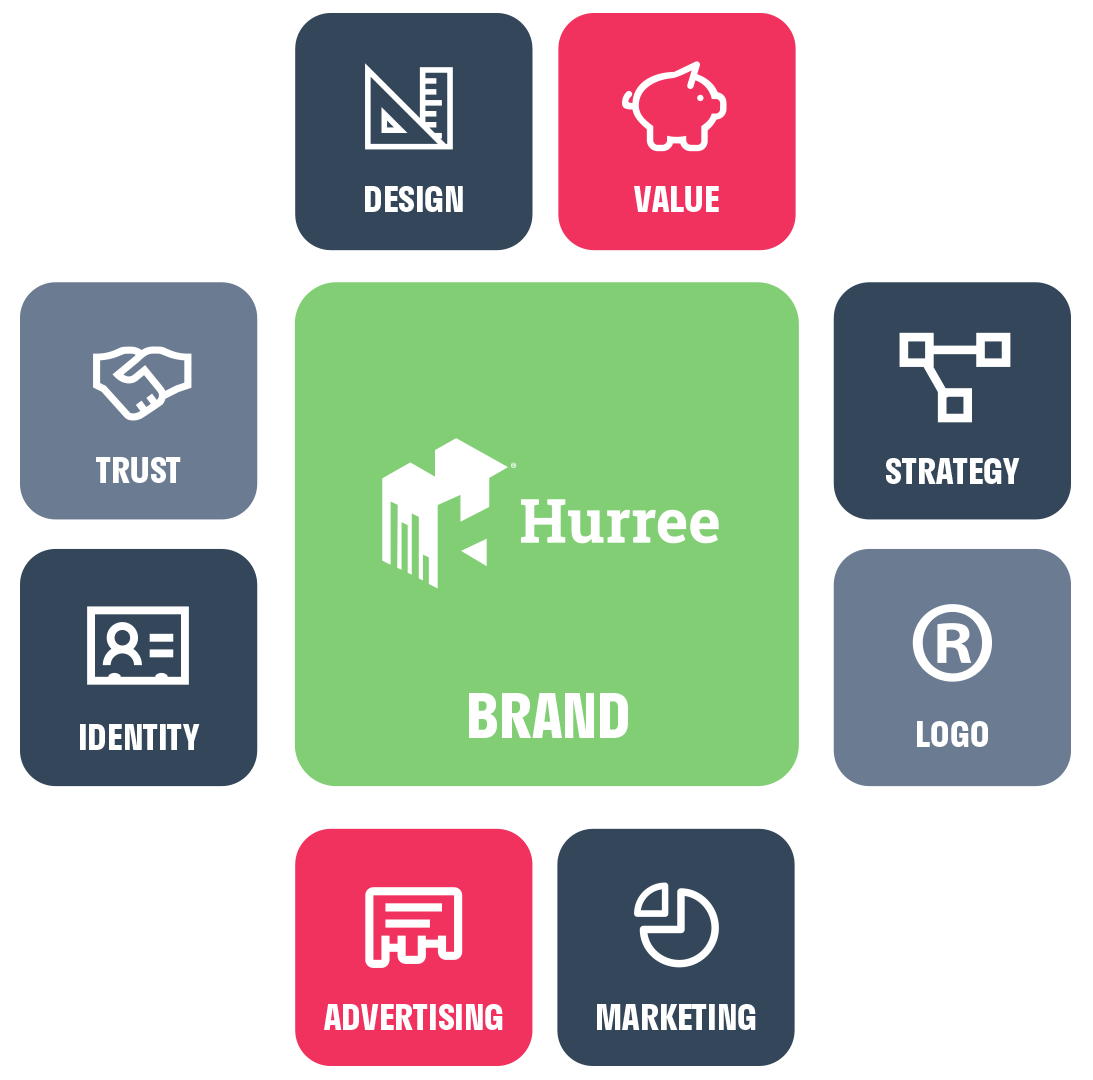
Building your brand involves a few different elements, including positioning, identity, voice, personality, and image. Let’s take a brief look at which each of these involve.
Brand positioning is the unique space a brand occupies in the brain of its customers. It is where your brand is positioned in comparison to the rest of the market. The first step of any branding project is to establish what draws customers to you in the first place. You need to explore, identify, and redefine what makes your company distinctive. Clever positioning is usually the reason why a consumer might choose to purchase a product from a specific brand, even when its competitors are offering something that is basically the same.
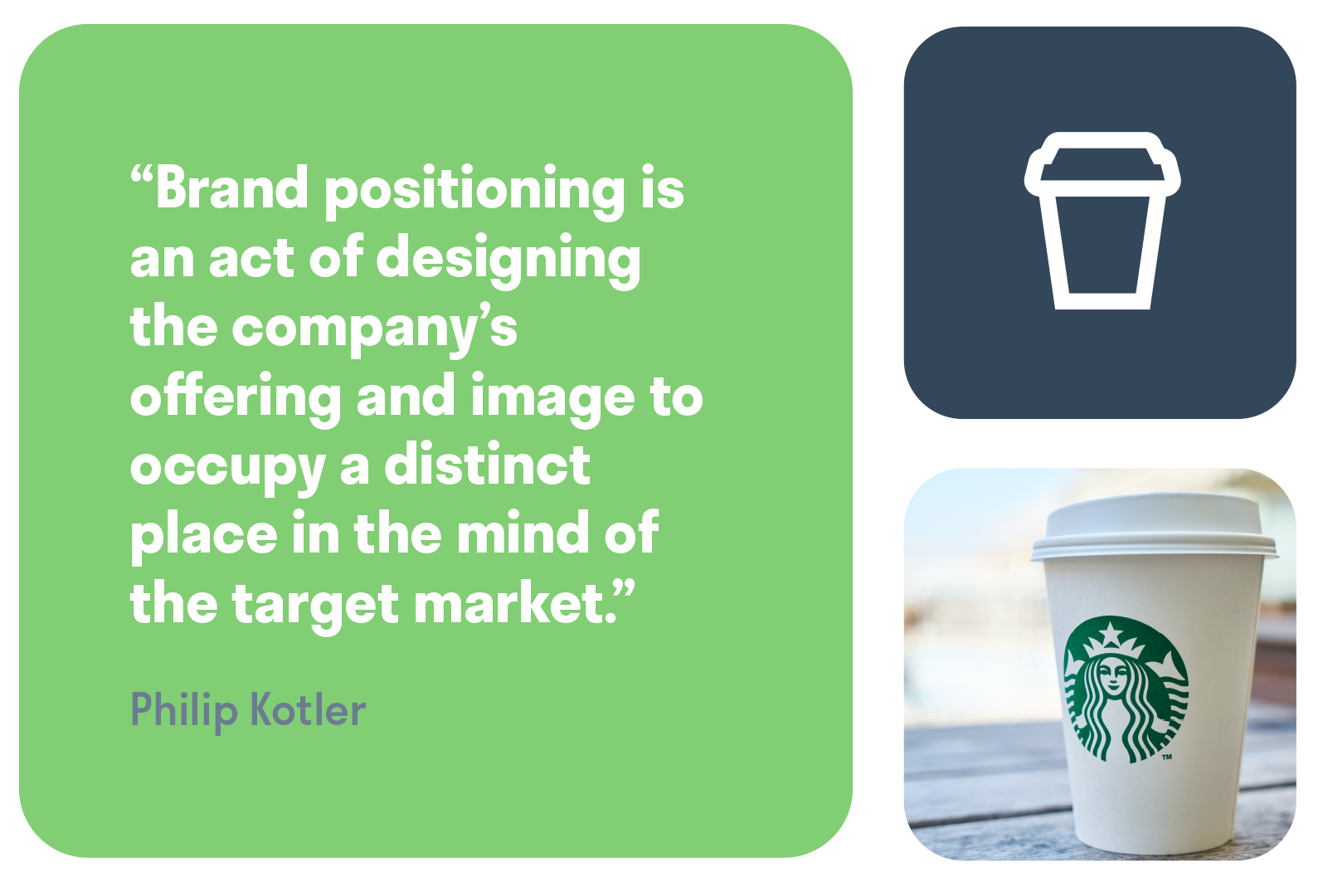
Positioning your brand is important for a number of reasons, for example:
Once you have established your brand position, you can then move on to focus on forging a positive identity that your customers want to return to time and time again.
According to Hubspot, brand identity is made up of what your brand says, what your values are, how you communicate your product, and what you want people to feel when they interact with you. Essentially, your goal is to create a lasting impression on both your customers and your prospects. Creating your brand identity is the process of shaping that impression.
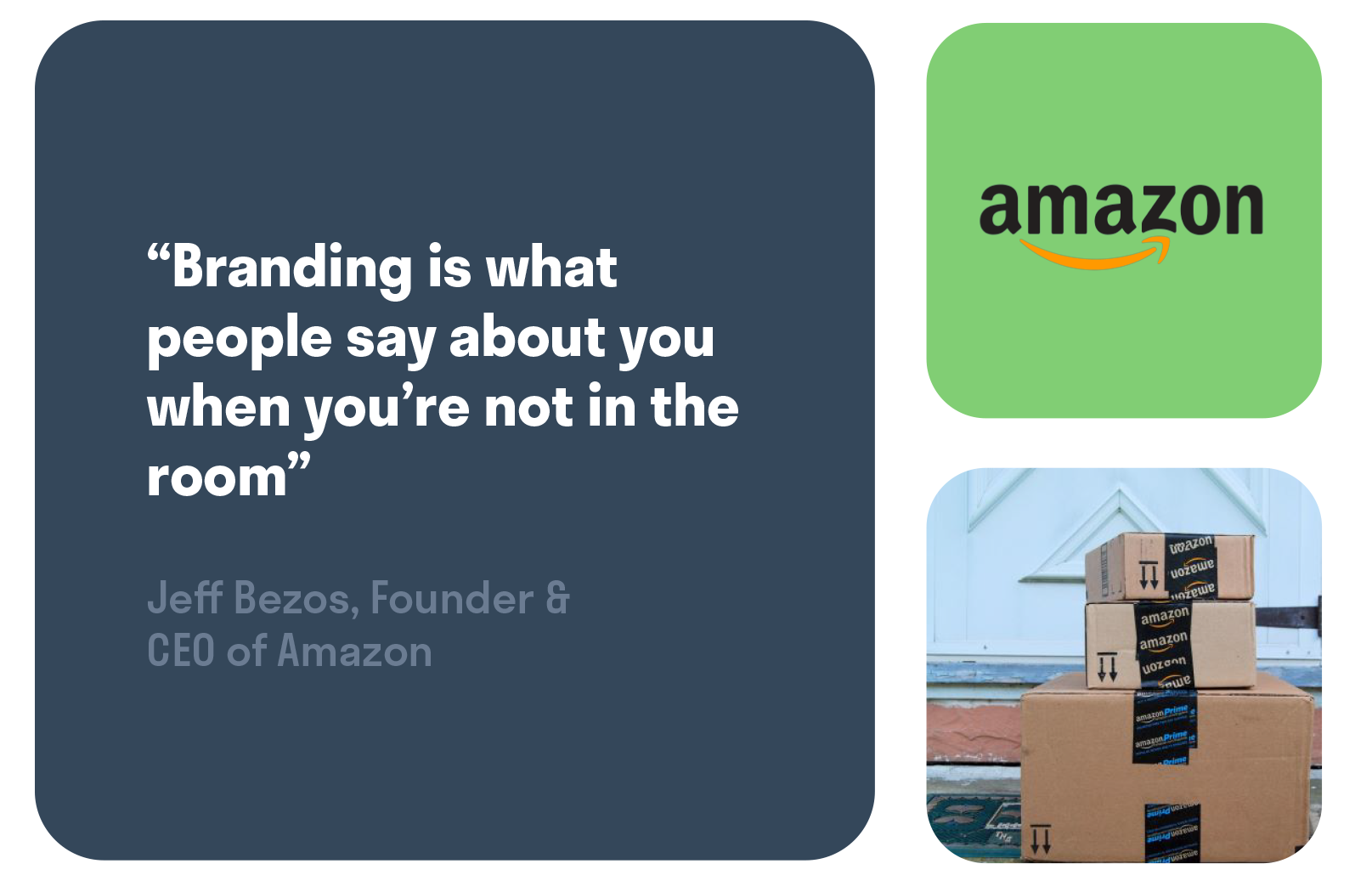
Distinct from your brand image, your brand identity involves the visible elements of your brand, such as color, design, logo, packaging, photography, uniforms, web design, etc. Basically, anything that represents your brand visually, these are the elements that enable your consumers to identify and distinguish your brand from others. For example, your website might contain some of the best content in comparison to all your competitors. But, if it doesn’t look visually appealing, to begin with, then it’s not going to capture the attention of your audience and all that good content you have created goes to waste.
Having a visually appealing brand design gives your company the competitive advantage of value, unity, recognition, differentiation, and pride. This is your opportunity to make a great first impression, so try to avoid the common branding mistakes. You won’t get the chance to do this again, so investing in your brand identity is vital for success.
Related content: How to Choose a Domain Name That Assists Your Online Marketing
While it can be easy to get them confused, your brand image is totally separate from your brand identity. The actual result you achieve from your efforts in building brand identity, be it successful or unsuccessful, is what makes up your brand image. It is the perception that your consumers have about your brand and it tends to develop over time. Consumers often base this upon any experience or interactions they, or their family and friends, may have had with your company. Someone does not need to have purchased a product or service from you in order to form an opinion on your brand image.
On some occasions, when you have a strong brand image, consumers purchase from you simply because they want to be associated with the product or service you offer. Nobody needs a $5,000 Chanel handbag. There are perfectly good, more affordable substitutes that will serve you the same purpose. But Chanel’s target market does not purchase their designer items to serve a purpose, they purchase them because of the exceptional image this leading luxury brand has built. They trust their products to be of the highest quality and owning them makes them feel exclusive.
There are many different advantages to having a strong brand image, such as:
It’s less about what you say, and more about how you say it. Having a clear brand voice is a vital element of your marketing strategy. Your brand voice is the tone, personality, and emotion that is injected into every business communication, be it via email, on your website, press releases, ads, social media, or even on your packaging.
As long as it goes hand in hand with your brand values and persona, your brand voice can be anything you want it to be. Whether it’s empowering, informative, playful, kind, funny, professional, ambitious, quirky, or authentic… the options are endless.

Having a consistent and personable brand voice allows you to connect better with your customers, build strong relationships, and increase consumer recollection. With a great brand voice, you can turn any piece of text into more meaningful content that almost feels ‘human-like’. This is key, considering a consumer is 4 times more likely to purchase from a company if they feel they have an emotional connection. The market is saturated with competition, so having a unique and memorable brand voice will enable you to stand out from the crowd.
In the same way that people differ in terms of how they communicate or behave, so does your brand. Consider that if your brand was a person, how would you expect them to dress? What sort of car would they drive? How would they speak or act?

Asking yourself these sorts of questions will help you establish the human traits of your brand. This is important because your customer may then be able to relate to these traits, therefore building an emotional connection between your brand and your customer.
Let’s take Apple’s brand personality as an example. As a person, Apple would certainly be the ‘cool kid on the block’ with their creative, innovative, and stylish traits.
Related reading: 5 Companies Who Nailed Their Brand Personality
You can communicate brand personality through tone of voice, visuals, customer service policies, and even how you treat your employees. The Five Dimensions of Brand Personality by Jennifer Aaker is a widely used framework to describe and measure the “personality” of a brand in five core dimensions, each divided into a set of facets.

By cleverly establishing your brand position, identity, voice, personality, and image you can gain a definitive edge over your competitors. Just be sure to follow the 5 key rules of branding and be specific, be authoritative, be consistent, be honest, and be relentless.
Think of your marketing strategy as a giant stew bubbling away on a stove. For your stew to be the tasty meal that your dinner guests are expecting, you’re going to need more than just one ingredient, aren’t you? Actually, you’re going to need to mix multiple ingredients to balance out the flavors and make everything work just right. That’s what your marketing mix is, a big shopping list of ingredients that are all essential to reaching your goals.
Related content: [Video] What Are The 7Ps of The Marketing Mix?
The history of the marketing mix is a lot like the concept itself; it's the product of a blend of multiple ideas. It first finds its origins in the 1960s with Neil Borden, who identified 12 variable marketing elements that, if controlled correctly, could return a “profitable business operation.”
Borden was inspired by the words of Culliton, who described business executives as “a mixer of ingredients, who sometimes follows a recipe as he goes along, sometimes adapts a recipe to the ingredients immediately available, and sometimes experiments with or invents ingredients no one else has tried.”
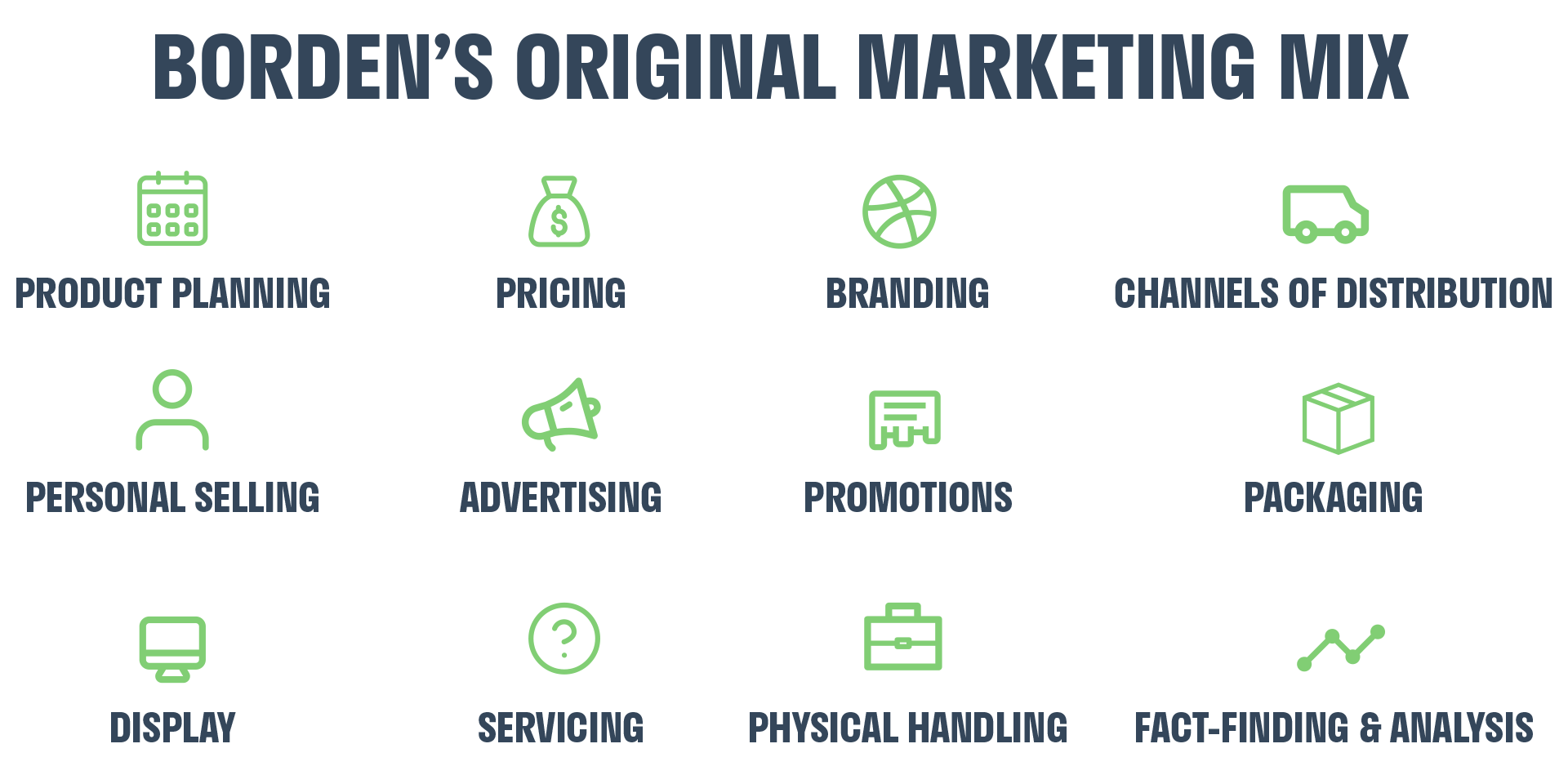
Later, Jerome McCarthy took the 12 elements of Borden ’s marketing mix and streamlined them into 4 high-level categories, which came to be known as The 4Ps. This model came to enjoy widespread recognition as an essential part of marketing theory and is taught to marketing students the world over.

The first element of the marketing mix is the Product, which makes sense as marketing exists to promote the sale of goods. Thus, Product is simply any goods on sale, ranging from physical products like a mobile phone to an experiential product like a ticket to a concert or even a service like window cleaning, for example. Whatever is on offer to the customer can be considered under the category of Product.
Researching the market where your product sits will help you to determine whether it is of niche or mass appeal and which segments of the market will be attracted to it. The quality of your offering is very important, as is your communication and description of it. Misleading consumers with false advertising of goods is not only disreputable, but it’s also illegal.
So, whenever you set out to promote your product, ensure it meets the market demand and meets or exceeds the expectations of your customers. Otherwise, you could be on the receiving end of some bad reviews, or worse!
Place encompasses all things related to the location of your products, where you choose to sell them or distribute them. The Place where your products are sold, housed and distributed can be a physical place like a store or a warehouse, or it can be digital like a website’s e-store, or cloud-based platform.
The real value of smart marketing is getting the right offerings, in the right Place, at the right time. So, it’s essential to evaluate the location where you conduct your business; consider your audience - are they offline or online shoppers? There’s zero point in shelling out month-on-month to rent premium space on the high street in a busy city if your target market largely shops online.
Research is the key to finding the right location for you and your customers. Remember, always consider what your competitors are doing, forgetting to do so may see them overtake you in certain locations.
Wherever you decide is the right place for you, ensure it’s of the highest standard and a great representation of your brand. If it’s a physical location, your store design must be easily accessible, clean, and aesthetically pleasing, and your staff must be pleasant and helpful to customers. Likewise, if you choose a digital option, be sure to invest in a good user experience (UX) to make sure usability, design, and security are up to scratch.

Money makes the world go round and, as such, the Price of your products is a big factor in the 4Ps of the Marketing Mix. Price is a primary component of the perceived and actual value of your product - the price must match your customers’ expectations and correlate with your budget.
Price can connote different characteristics of products; a high price tag, in some cases, can imply luxury and exclusivity, but this is largely dependent on the brand’s reputation and promotional styles such as advertising and tone of voice. However, do not purposely over-price your products. This will have a negative impact if your goods do not live up to the price paid for them, if they’re made poorly or break quickly, for example. Similarly, a low price tag suggests a budget item, which can give some customers the impression that your product is of low quality. Thus, it is important to value your product precisely based on its quality, longevity, and how it compares to its competitors.
One factor that will also impact the price of your products or services is supply and demand; how many units of your product exist and how many people actually want it? Supply can either be infinite, like a digital software product or limited and exclusive, like a Tesla car, for example.
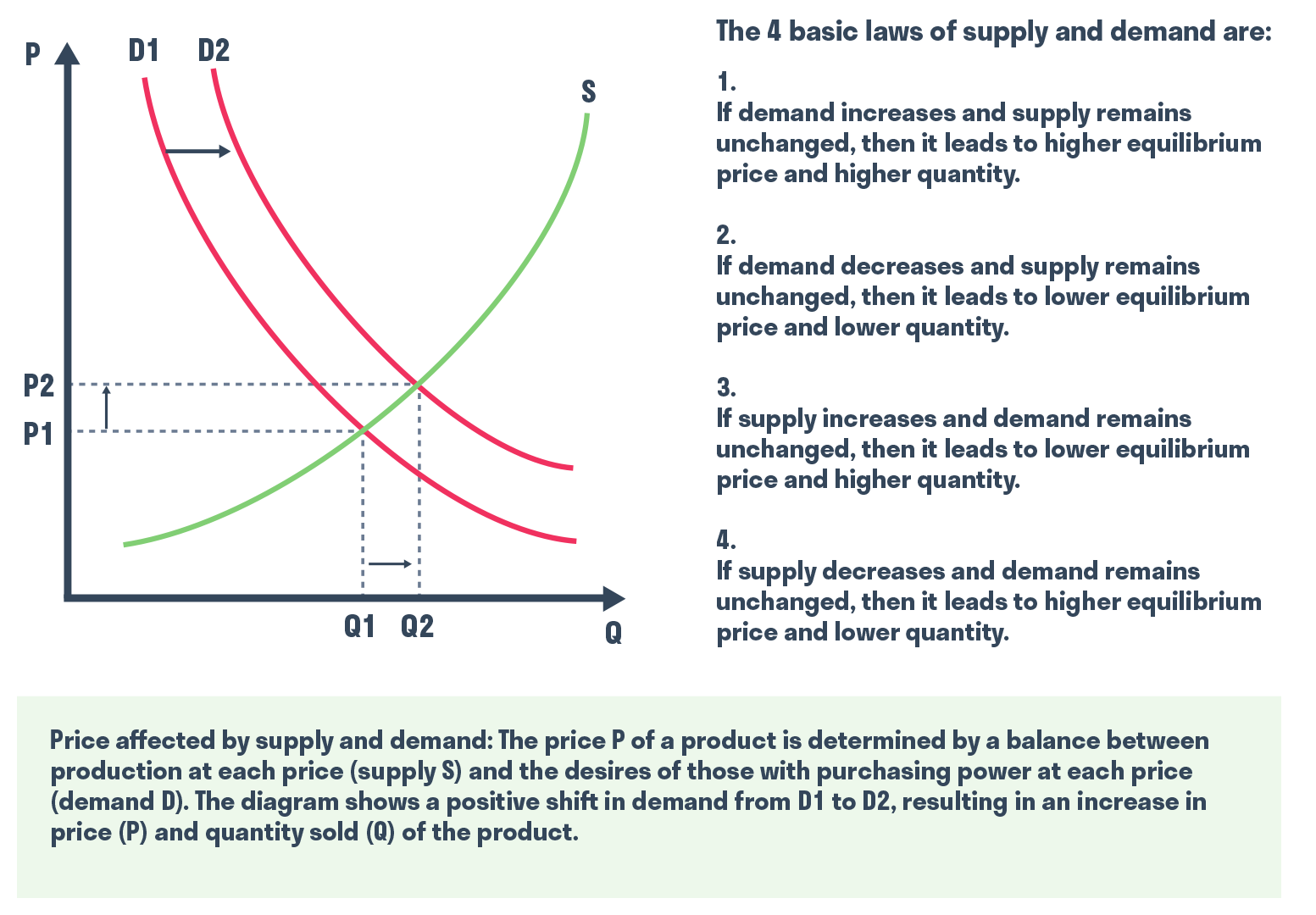
Source: Lumen
Promotion refers to the marketing tactics that you employ to spread awareness of your products or services. These tactics can be anything from traditional methods like television & radio commercials, billboards, direct mail, and cold-call marketing to more modern, digital methods such as email, social media, digital advertising, content marketing, and beyond.
Researching your target audience and the channels on which you are most likely to reach them is a crucial step in planning your promotional strategy. Different demographic segments of the population will accept and respond to marketing in varying ways, times, and frequencies.
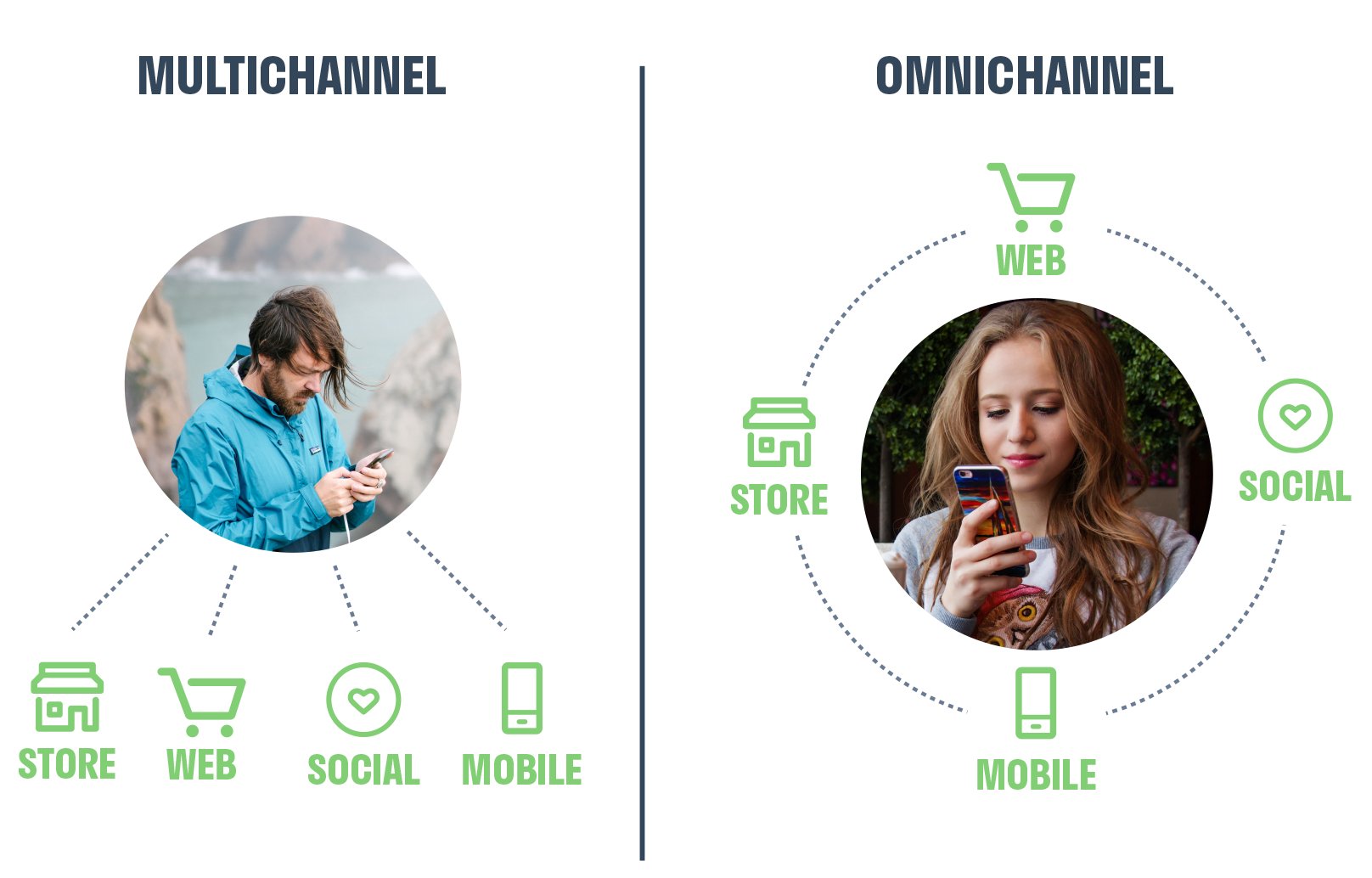
Source: Acquire
Whatever tactics you choose, your promotional strategy should be omnichannel; this means your promotional communications are consistent across all the channels where your brand interacts with potential and existing customers. Creating a consistent customer experience throughout the entirety of the buyer’s journey is important for your brand’s reputation. Every user touchpoint counts.
Related Content: Experiential Marketing: 4 Es to Future-proof Your Strategy
As time moves forward, so too do marketing methods and the 4Ps. In the late 1970s, it was widely acknowledged that the 4Ps needed an update, and with that, Booms & Bitner added 3 more Ps to the model.
So, what did they add?
Trust is a huge part of whether or not a consumer chooses to purchase a product from your company. That’s why Physical Evidence was added to the marketing mix as it can give your business the credibility needed to encourage trustworthiness among consumers.
The physical evidence that we are referring to here is anything that proves your business is real and operating within the law. After all, no one wants to buy products from a company that seems shifty and is not secure. Physical evidence can range from invoices, order confirmations, and receipts to your physical stores, a social media presence, and a legitimate website.
Keep in mind that customer reviews are incredibly important within the modern market, and many consumers prefer to hear what your previous customers have to say about your products and services over your business's direct promotions. Make positive reviews easily accessible on your website and your social media profiles, and ensure that you reply to all negative reviews in a professional and timely manner.
Your business is only as great as the people you choose to represent it; that’s why this P is vital at every level of your business. Everyone from your CEO and sales representatives to your store clerks, warehouse packers, and delivery drivers are a representation of your brand as a whole.
Upholding company values such as being committed to customers, conducting roles within healthy & safe guidelines, and working as a team is key from the employee’s side. However, your employees can only do this with adequate training, leadership, recognition, and support from your side.
Take care of your employees, and they will become promoters of your company. Modern consumers are more conscious and ethically focused; they have concerns about workers’ rights, a fair living wage, and want companies to provide a safe working environment for their employees.

What steps are required to deliver your product or service to your customers? Here, you must consider which activities, functions, and tasks must be completed, in what order, and what is required logistically to ensure that employees can complete these processes to a high standard. This may require investment in technologies such as CRM, logistics software, payment systems, etc.
Understanding and consistently evaluating your company processes will allow you to identify roadblocks within your sales funnel and areas where you could streamline to improve your customer service experience.
An awareness of processing trends will help your business maximise your budgets and stay ahead of the competition. Do not be afraid to take risks and innovate with new platforms to ensure that you can deliver the best for your customers while still driving profitability for your business.
The Startup Growth presented an overview example of how a digital marketing agency may formulate their marketing mix in terms of PPC (pay-per-click) services:
Product — Pay-per-click advertising services
Price — $499 — $1,999
Place — Remote work, website
Promotion — Run ads on Google Ads and send prospects to a custom landing page.
People — Google Ads certified resources to work on client accounts.
Processes — The steps needed to deliver the PPC service to the customer.
Physical evidence — Send brochures, customer testimonials, company reviews, proposals.
The marketing mix is a useful guide for any business planning their marketing strategy. Each element is equally important as the next and requires a level of research to ensure the cumulative parts are as effective as possible.
Related reading: What is Marketing Mix Modelling? 3 Benefits & Limitations
Digital marketing is a vast and extensive topic, so it’s tough to know where to start.
According to Neil Patel, digital marketing is:
“any form of marketing products or services that involves electronic devices.”
In this definition, Patel places the initial implementation of digital marketing as far back as 1896, with Guglielmo Marconi, who is said to have invented the radio. However, in the opinion of most industry experts, whilst radio is technically a digital product, it should fall under the category of ‘traditional marketing’.
Another, more commonly accepted definition of digital marketing comes from Hubspot:
“Digital marketing is an umbrella term for all of your company's online marketing efforts.”
In this definition, they include examples of the primary digital tools and tactics that we know and love such as social media, sponsored advertising, email, push notifications, and content.
But digital marketing encompasses so much more than just these primary methods; each approach in itself has a multitude of forms, functions, and features that help to advance, elevate, and optimise your brand.
Consider the 5 Ds of digital marketing:
So why has digital become such a dominant tactic in modern marketing? Simply, because of the relentless growth and prominence of the internet. According to Statista, the number of internet users in 2009 was around 1.7 billion, that number increased to 4.13 billion in 2019. To put it into perspective, that’s an increase in internet usage of more than 142.9% in the past 10 years.
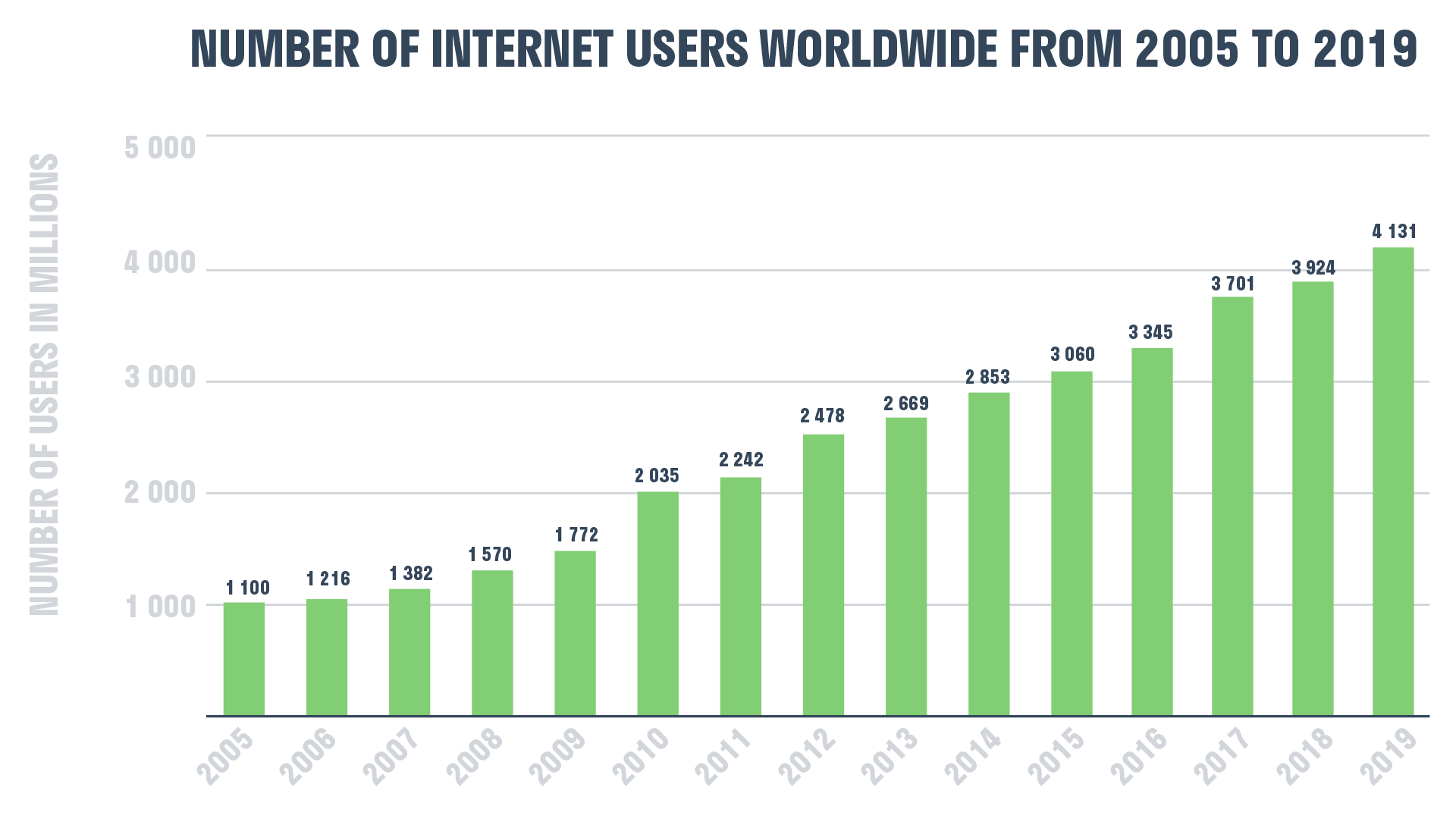
Research by Oberlo found that there are over 4.33 billion active internet users worldwide (in 2020). That’s around 55% of the total population. At this point in time, having an online presence is essential for any brand looking to see continued growth. Consumers now expect and rely on it; so having a website, a digital ad strategy, or even just a social media profile establishes to current and prospective consumers that, if nothing else, your brand is legitimate.
But digital marketing methods aren’t solely there to convince people that you exist; they offer variety and creativity in your strategy, they help you to monitor and manage the success and ROI of your campaigns, they help you to experiment, to discover new tactics, and bring you closer to achieving your goals.
Source: Hubspot
Businesses use email marketing to communicate with their audiences. The function of email communication stretches further than simply product promotion. The types of emails that a business might focus on within their strategy include the likes of:
Related reading: How To Build The Perfect Onboarding Campaign
Email marketing is super efficient because it enables you to easily segment your audience, meaning that you connect with the right people, in the right place, at the right time, and in the right way.
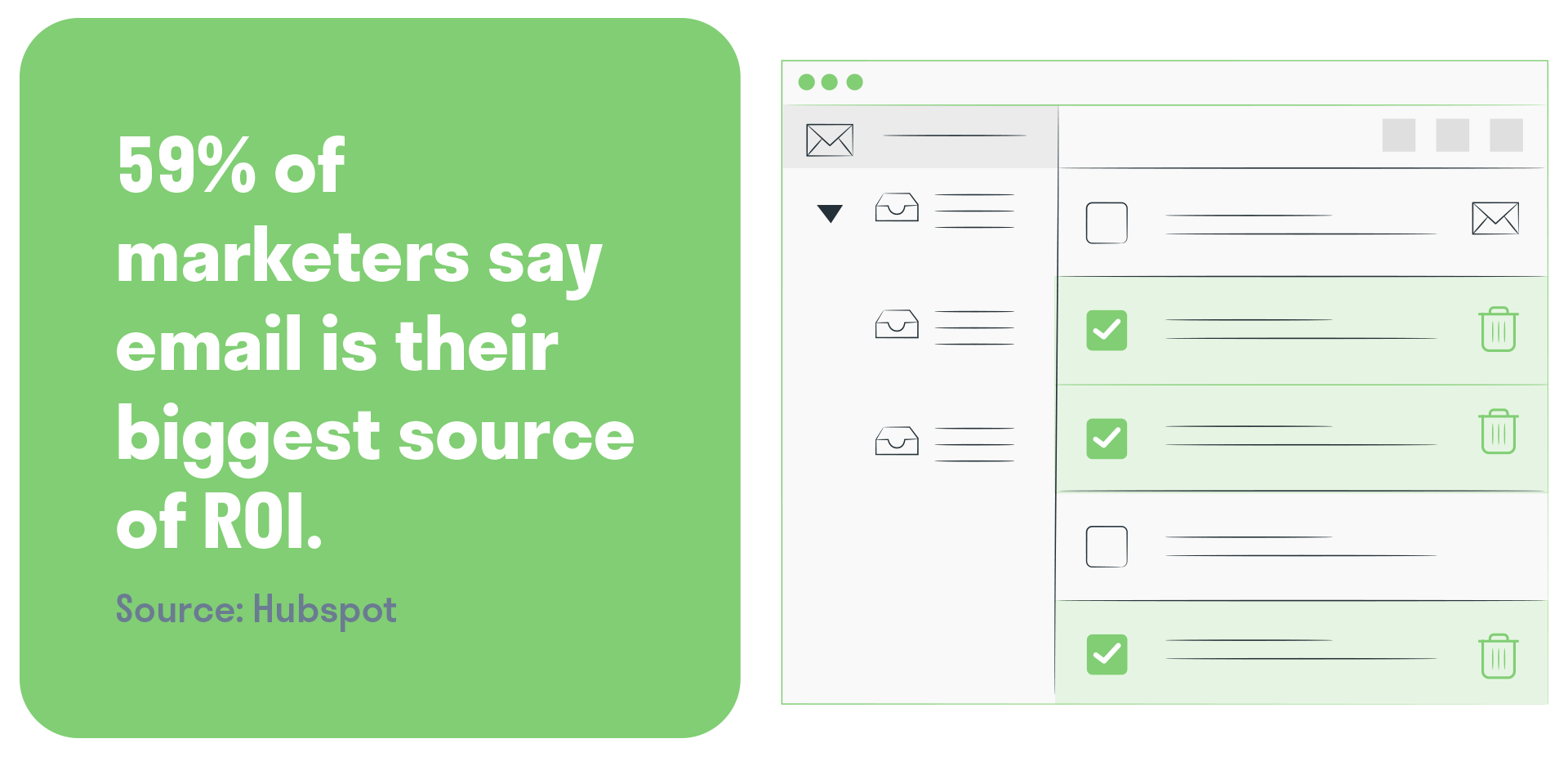
You can fully personalise emails by creating specific lists, automating messages based on time, contact details, or contact behaviours, and you have the freedom and ability to design emails that are creative and on-brand.
Retaining engagement and offering information via email is a great way to remind your customers of your presence, of your value, and it encourages loyalty. And email marketing is shown to be one of the most popular and effective tools for growing your brand.
Related reading: How to Decrease Inactive Users with Email Marketing
A primary component of digital marketing is mobile marketing. Mobile is a form of digital marketing that focuses on connecting with users via their smartphones and tablets, and typically consists of targeted ads and messages that appear on a user’s device. When it comes to design, customisation, personalisation, formats, and functions, the options for general mobile marketing are varied and vast.
Research by RescueTime found that the average person spends 3 hours and 15 minutes on their smartphone every day. And the top 20% of smartphone users’ daily screen time is in excess of over 4 hours.
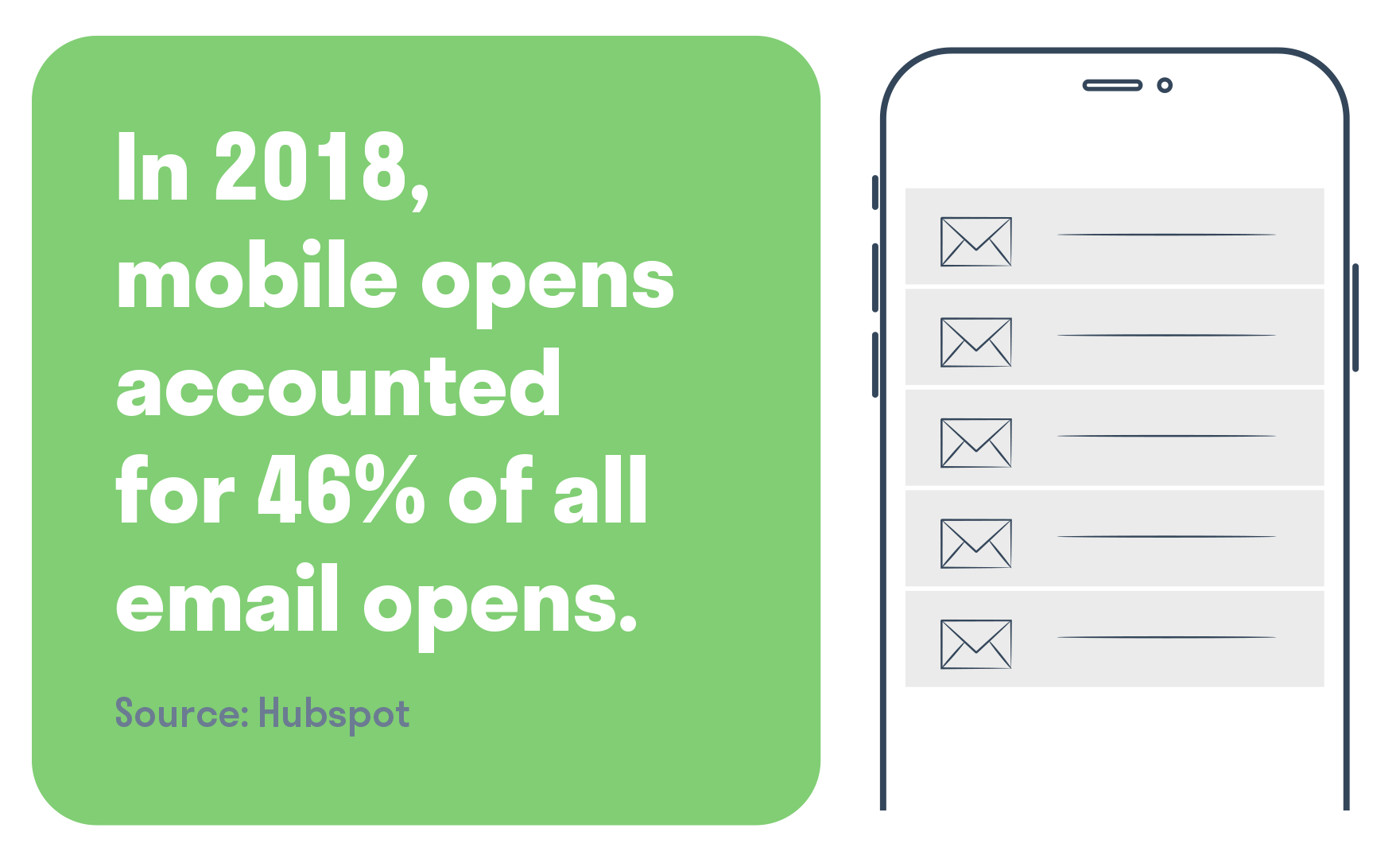
But what does this mean for marketers? Does it change anything? There’s one keyword that springs to mind: optimisation. Yes, that’s right. Do you have a website that’s designed for desktop users? You better optimise it for mobile. Have you just created a digital ad? You better make sure it’s mobile-friendly. Do you post images on social media? You better optimise… Ok, you get the picture. As smartphone usage accounts for 69% of the time people spend consuming digital data (in the U.S. alone), optimising your digital marketing strategy is vital.
We live in a digital age; today peoples’ mobile phone bills are mostly priced based on data usage, and free wifi access is almost guaranteed. This means that mobile phone usage is now such an integral and normalised part of society, like driving your car to work, making lunch, going for a walk, or listening to music, that if you’re not targeting mobile phone users, you’re truly missing out.
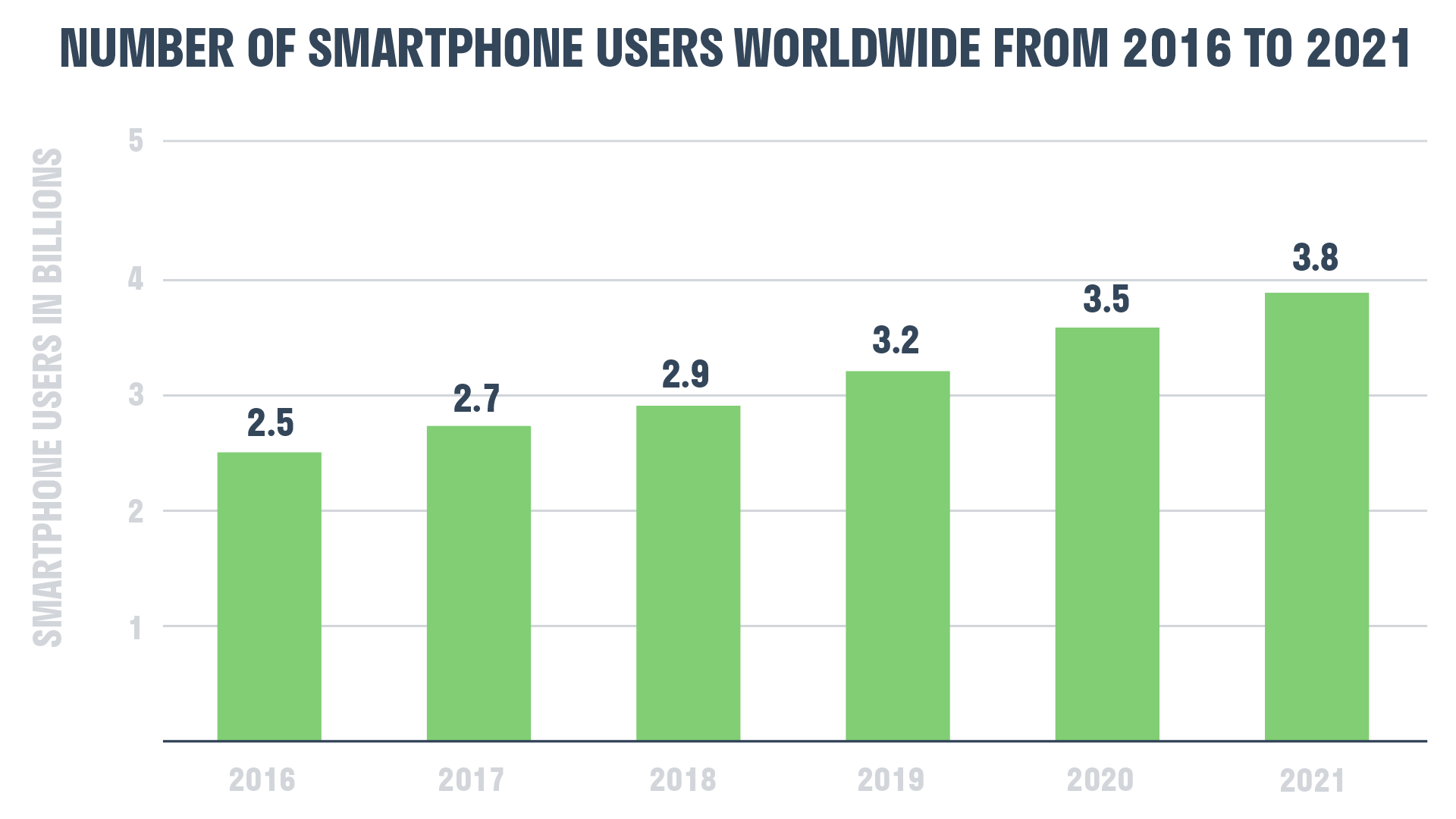
Source: Statista
With the number of smartphone users worldwide set to increase in the coming years, mobile marketing shows no signs of slowing down, so be sure to optimise in the right way and make mobile a key player in your marketing strategy.
Social media marketing sees brands using social networking platforms as an outreach tool with the primary focus being to connect with current consumers and prospects.
Social media has become a fundamental feature for brands in recent years. Its leading function is no longer just content sharing with the aim of generating traffic. It has evolved to become much, much more.
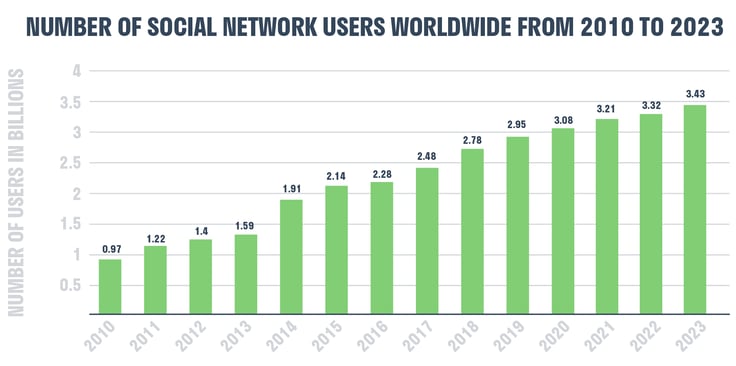
Source: Statista
Let’s assume that Statista’s data gathering and predicted outcome is correct and that, by the end of 2020, there will be 3.08 billion social media users worldwide, that number creeping up ever-so unsubtly. That means that in the past 10 years, social media usage has seen an increase of over 215%.
Social media has matured in recent years to the point where it’s no longer just a place where people host images or scatter random thoughts. These platforms now contain real, usable data; valuable information that brands can utilise in order to provide their audiences with content, messages, knowledge, and insights that are meaningful and highly personalised.
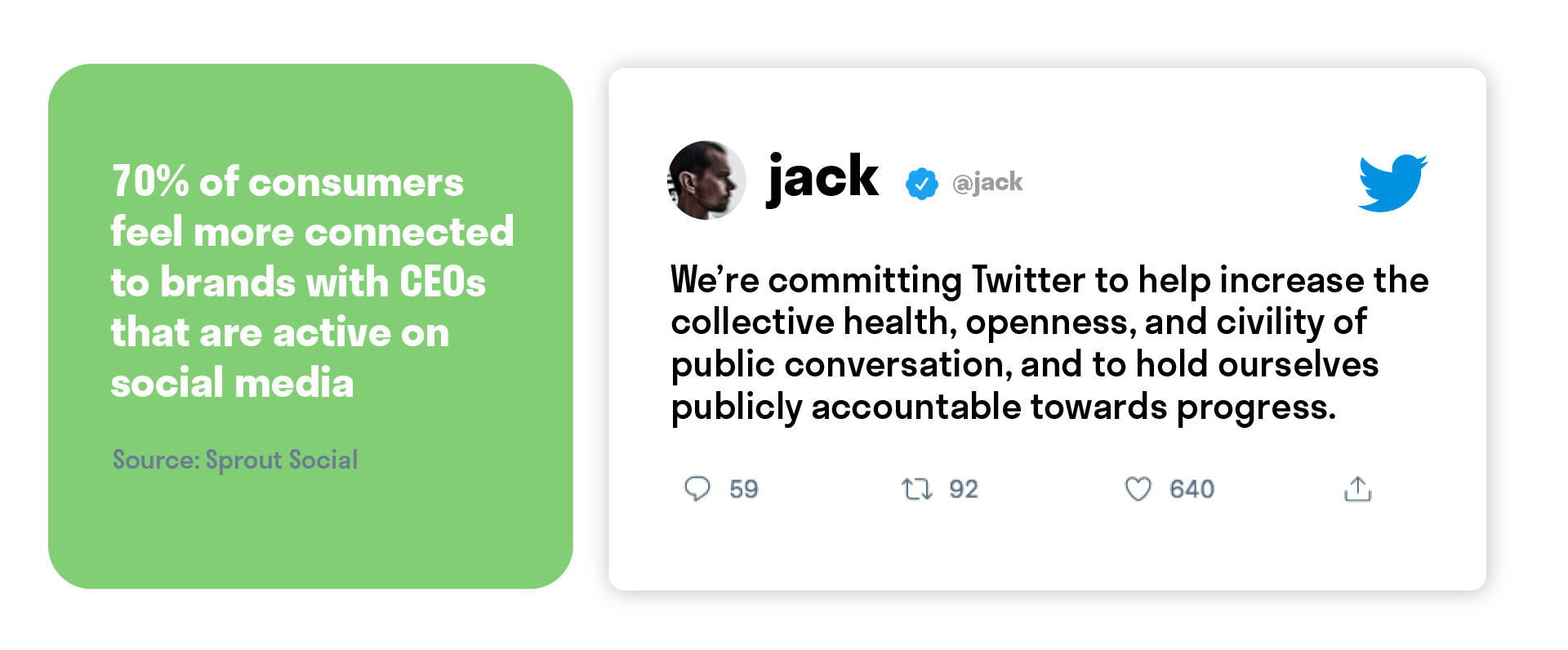
Brands can use social media analytics to focus on areas that specifically interest them and the market segments that they aim to target, i.e. using social listening for relevant mentions, tracking behavioural tendencies such as engagement rates, clicks, reach, and generally gathering specific nuggets of information that are used to make informed decisions and bespoke communications.
Source: Lyfemarketing
Social media has also paved the way for a whole new avenue of advertising. Due to the wealth and variety of data that social media enables businesses to gather and analyse, advertising can be automated, optimised, and highly targeted based on demographic, geographic, psychographic, and behavioural information. Like many forms of digital advertising, social media typically utilises a PPC method to increase traffic to websites, boost brand awareness, or promote specific products and services.
It’s incredibly uncommon to find a successful brand that does not utilise social media. That’s why social media marketing should have a firm and consistent place in your marketing strategy.
When it comes to reaching prospects, the traditional ‘hard sell’ just doesn’t cut it anymore. People no longer want to be pushed, prodded, and treated like nothing more than a sale. They want things that are meaningful, valuable, and relevant to them. That’s why content marketing has become a prominent and favoured approach for marketers globally.
But what is it?
According to the Content Marketing Institute:
“Content marketing is a strategic marketing approach focused on creating and distributing valuable, relevant, and consistent content to attract and retain a clearly-defined audience — and, ultimately, to drive profitable customer action.”
Essentially, instead of pitching your products or services, you create and present content that is useful, educational, entertaining, enlightening or simply helps consumers to deal with an issue.
Content marketing comes in many forms:
And more! Including the likes of white pages, books, and webinars. Ultimately, one of the most important things to consider when including content marketing into your strategy is relevancy; is this content relevant to your current and prospective audience? For example, if your target audience doesn’t really reside online, then you should look for different avenues to reach them.
Related reading: How to Create an Effective Content Marketing Strategy (7 Steps)
Content marketing is a great way to promote your brand and your offerings in a way that gives something back to your audience. Additionally, if your content marketing is to a high enough standard, you will have the highly sought-after position of being a ‘thought leader’ in your industry.
SEO stands for Search Engine Optimisation. SEO is the process of optimising aspects of your website and content in order to increase the quality and quantity of targeted traffic your website receives.

First, consider the ‘search engine’ aspect of SEO. When you search for something on Google, Bing, Yahoo!, or any others, the search engine uses an algorithm to crawl the internet in order to find what it thinks is the ‘best’ result for what you’re looking for.
According to Backlinko, websites and web pages are ranked by Google based on these 3 main factors:
This relates to the keywords that are used in your search. The search engine will rapidly explore the internet to find a piece of content that closely relates to your keywords. For example, if you type in ‘the essential guide to market segmentation’ you might just see this as your result:
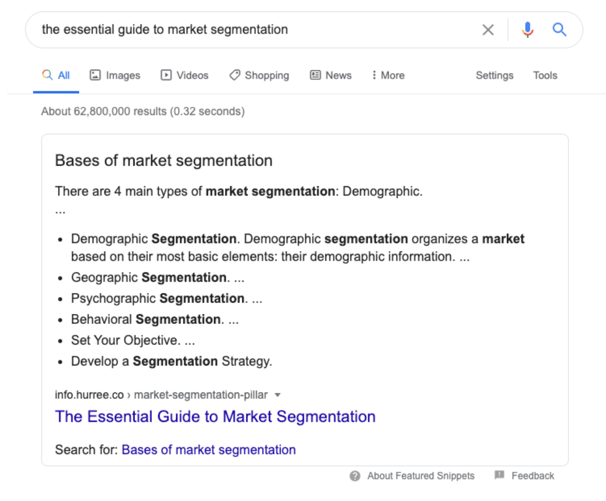
But if you look just underneath your search, you will see that Google has produced 62,800,000 results in 0.32 seconds. So search engines don’t display results based solely on relevancy; this is where our 2 other primary factors come in.
Search engines determine the authority of a website or piece of content based on authoritative indicators such as reviews, affiliate programs, and backlinks, i.e. the number of other pages that link back to that page.
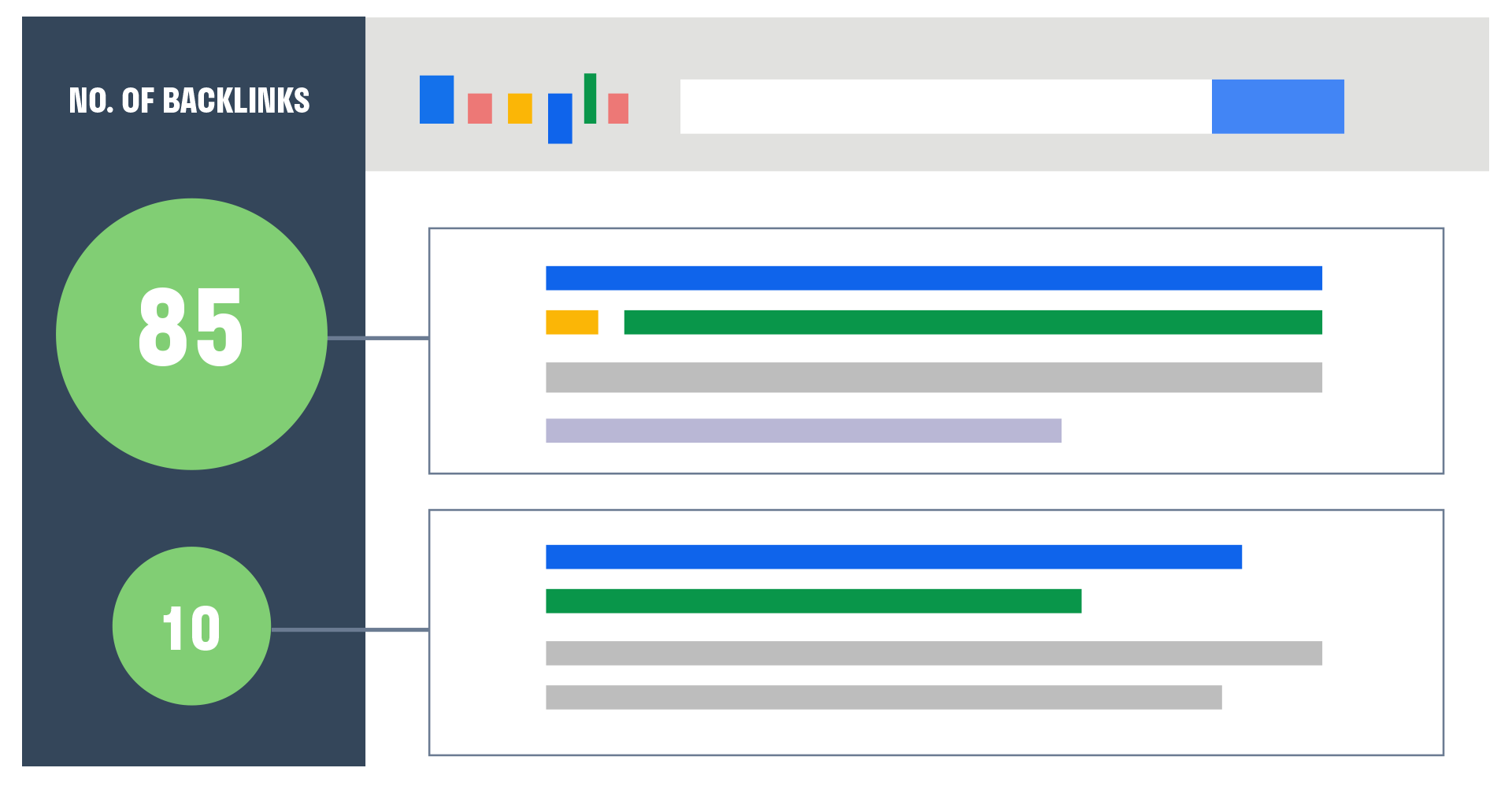
Typically, the more backlinks a page has, the higher it will rank in Google.
Content can’t just be relevant or authoritative, it must also have a use. If your content is not seen to be useful then, unfortunately, Google won’t want to rank it highly. But what does ‘usefulness’ actually mean? According to Google’s long-term Staff Software Engineer, Ryan Moulton, there has to be “a balance between popularity and quality”.
For example, if you search ‘how to get rid of the invasive plant species Japanese Knotweed’, there will likely be two different results that appear: one might be an academic article that describes the plant and its ecological effects using scientific jargon which most people won’t understand. Another result might come from ‘wikiHow’, a Wikipedia-style community that creates ‘how-to’ guides using simple descriptions and helpful images.
The scientific article will rank highly in Google due to its high-quality content and the number of backlinks it has within the text. However, the wikiHow result will also rank highly as the content is organised into clear sections, full of keywords, and because of its ‘user signals’ or behavioural patterns.
That’s just the search engine part. Optimisation comes into play from the side of the website host, and there are a number of key areas to take into account when it comes to optimising your website or web page:
You can use the likes of Google Keyword Planner to help you learn the average number of monthly searches for your keywords, the competition these keywords see on Google Search, and much more.

Of course, as with most digital marketing practices, SEO is constantly evolving. From Google’s algorithm updates to the increase of use in digital voice assistants, SEO is a vitally integral part of your digital marketing strategy.

The digitalisation of most businesses, and the amount of current consumers and prospects that now reside online, means that paid, digital advertising has flourished. There are typically 5 main types of paid ads: Display, Search, Native Advertising, Social Media, and Remarketing. And almost all of them use the ‘pay-per-click’ (PPC) approach.
We’re going to explore a brief rundown of each common aspect, (bar social media as it’s been discussed previously) and the benefits involved with each one.
Display advertising refers to digital advertisements that use text, imagery, gifs, video, or any kind of rich media. The aim of display ads is to raise brand awareness and to encourage potential leads to ‘click’ by being prominent on a web page and visually enticing, just like this:

The aesthetic nature of display ads demands attention from viewers and therefore encourages a target audience to take action, i.e. click-through to a blog post, make a purchase, or subscribe to a newsletter, for example.
Source: Hubspot
Display ads usually appear when people are consuming content. Take the likes of Forbes: if you click on an article by Forbes, you will notice an eye-catching banner ad at the top of the page. You will also notice the little square branded image alongside the article and the video that’s initially at the top right-hand side of the page but moves down to the bottom left when you scroll down.
For some readers, this might be a little overwhelming - an excess of visual stimulation, which will encourage them to exit the page. However, for many readers, these aesthetically prominent ads prompt the desired result - a hasty click.
When it comes to understanding search ads, the clue is in the name: search ads occur on a search engine results page (SERP). This means that they appear whenever someone actively enquires about a topic, looks for solutions, or searches for a brand, their products, or services via a search engine.
Despite having a little ‘Ad’ label on them, search ads typically look like organic search results. Here’s an example that you will likely be very familiar with:
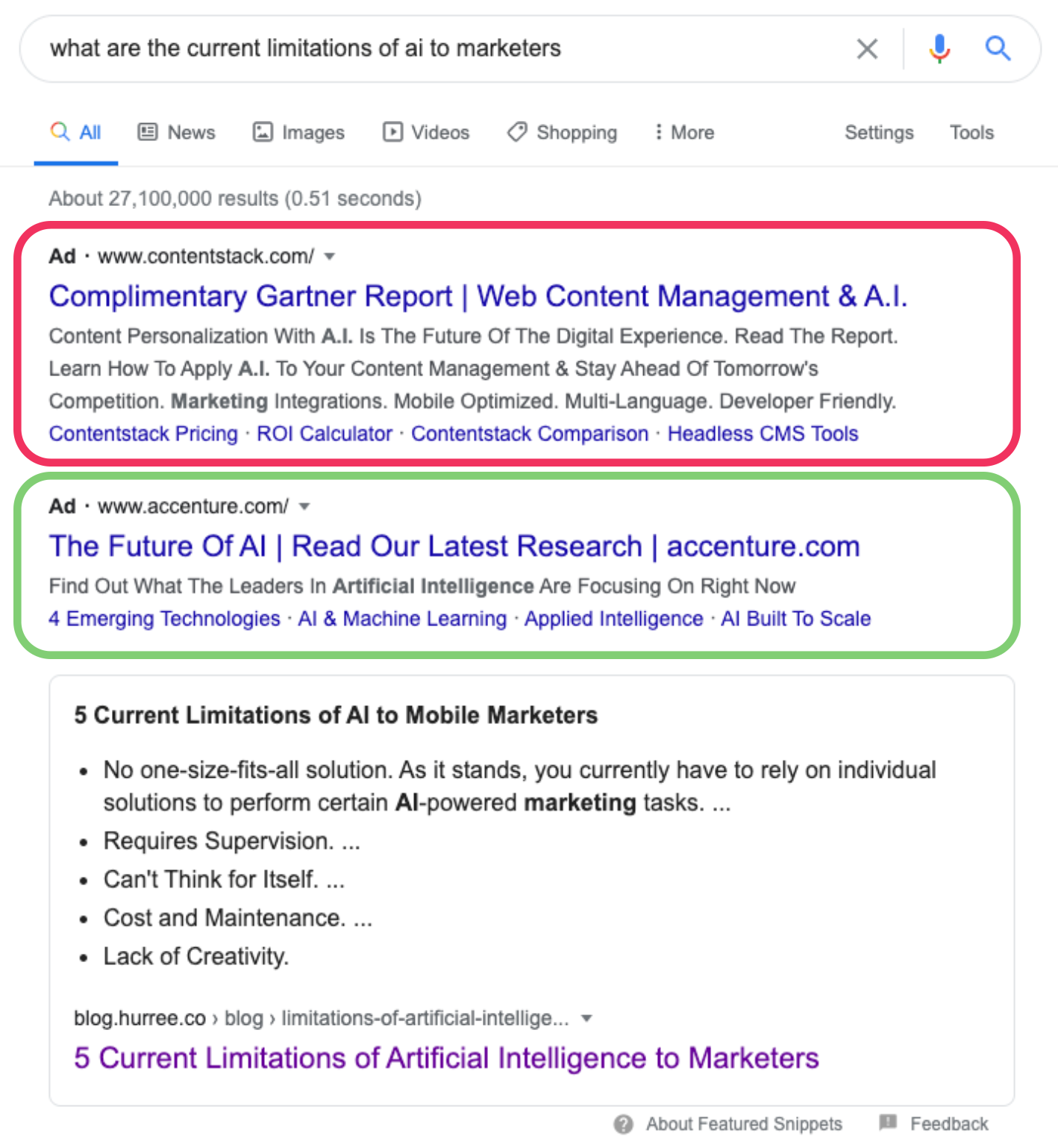
Remarketing is a term that’s thrown about a lot today. Often confused with retargeting, remarketing is a promotional technique that aims to re-engage consumers who have shown an interest in a product or service somewhere on the internet.
Remarketing is made possible through data collection; browser cookies, user IDs, and mobile advertiser IDs. They’re implemented when people visit your site, use an app, or interact with your brand on social media. Remarketing is essentially a way of ‘following’ consumers with hyper-targeted, personalised ads.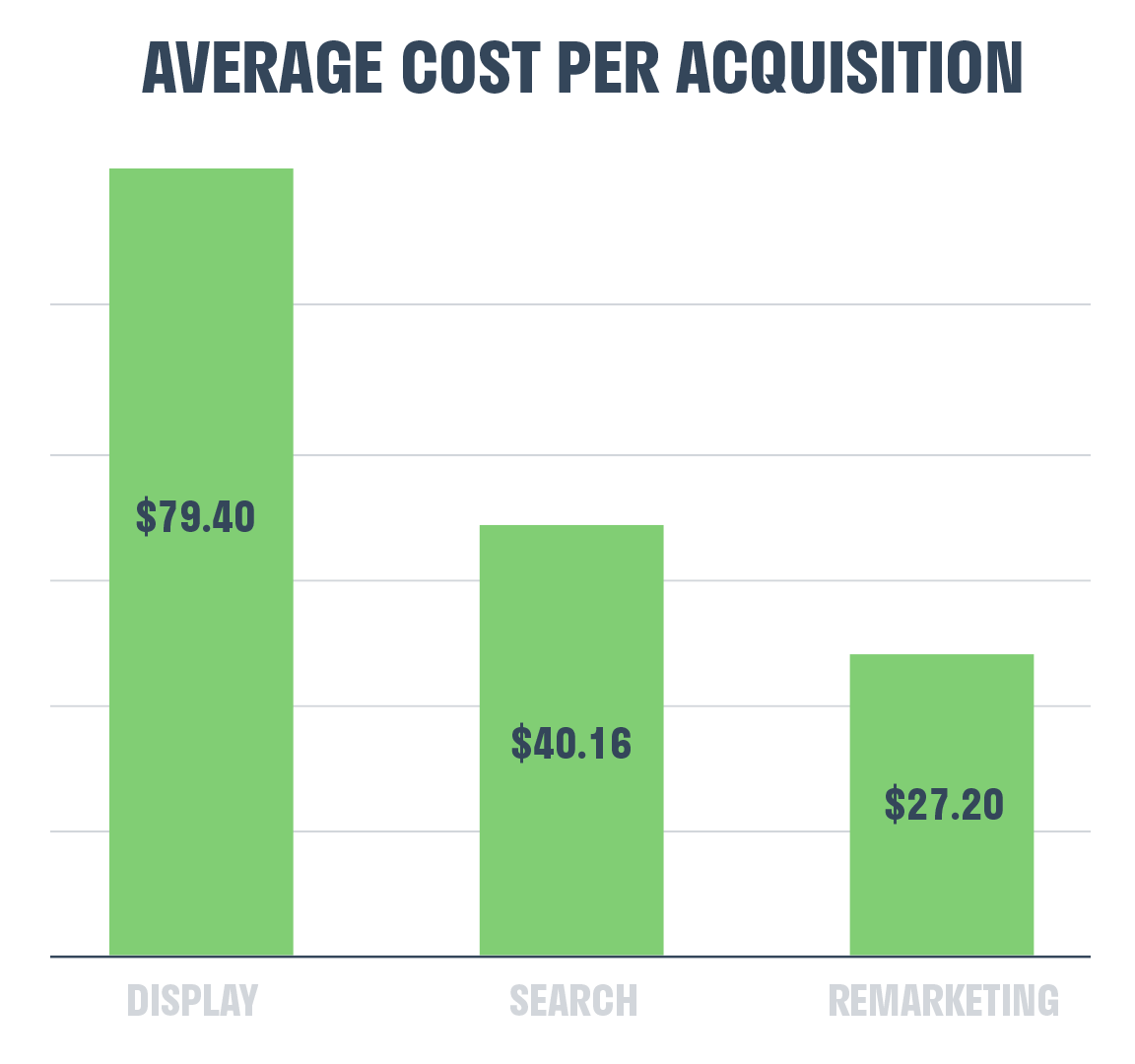
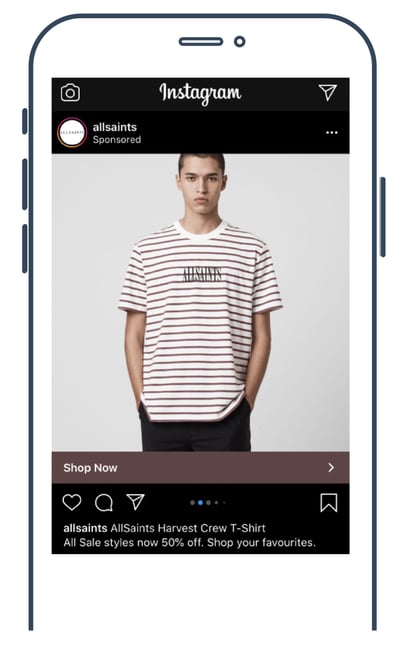
Source: Outbrain
Research shows that the average CTR for native ads is between 0.8% and 1%, that’s over 50% higher than the average CTR for standard display ads. A lot of native advertising is based on remarketing, which is one of the reasons why they see more interaction than the likes of display ads: they’re relevant. It’s this level of personalisation that entices your prospective audience and retains your current, loyal consumers.
![What is Native Advertising? [infographic] The Essential Guide to Marketing Strategy](https://no-cache.hubspot.com/cta/default/2080894/3fd84a71-999b-4607-9e65-af35e7b4892d.png)
Push notifications are short messages that are delivered to a user’s device via an app or website. They can be media-rich and also contain a CTA (call-to-action) which aims to prompt the user into making an action like revisiting the app or accessing a particular product, for example.
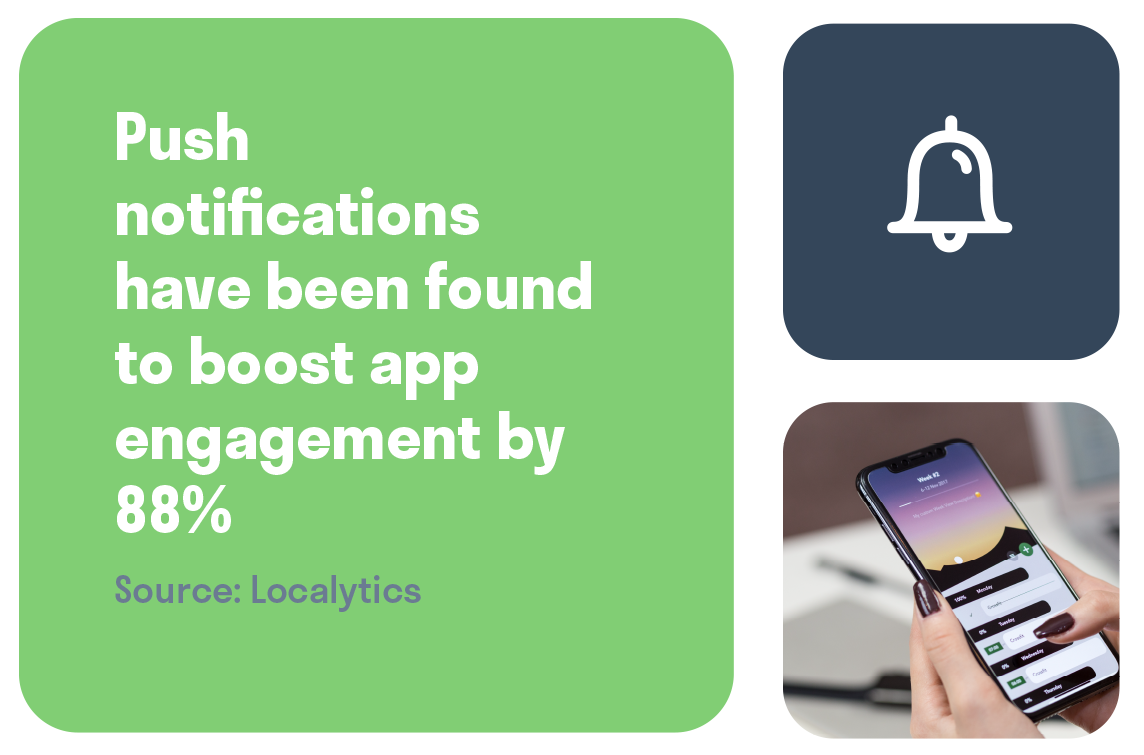
Most brands now use push notifications. If you have an app on your mobile phone, chances are that, as soon as you initially enter the app, you are told that the app would like to send you push notifications. Essentially, push notifications are here to stay. But with the huge array of apps flooding the market, it’s important for brands to make their push notifications something special and avoid the dreaded opt-out. This means they must have a great design, offer valuable content, and the messages must be relevant to the user.
Traditional marketing essentially refers to any kind of marketing that doesn't reside online. This means television, radio, print media, direct mail, and referrals. Similar to digital marketing, traditional marketing is broad and each aspect encompasses a number of different and specific features.
For example, if you include television marketing in your strategy, the methods and intricacies of TV marketing will be entirely different from the likes of, say, print marketing.
Contrary to what some may think, traditional and digital marketing aren’t mutually exclusive; many brands incorporate both forms of promotion in their strategies in order to broaden their horizons and ensure that they are seen in at least one place.
It’s true that most businesses will use some form of market segmentation, meaning that they will know whether or not their target audience is mostly online, offline, or a mix of both. But in order to be heard amongst the huge array of promotions and advertisements that are present in our lives, experimenting with a variety of marketing methods is not a bad thing.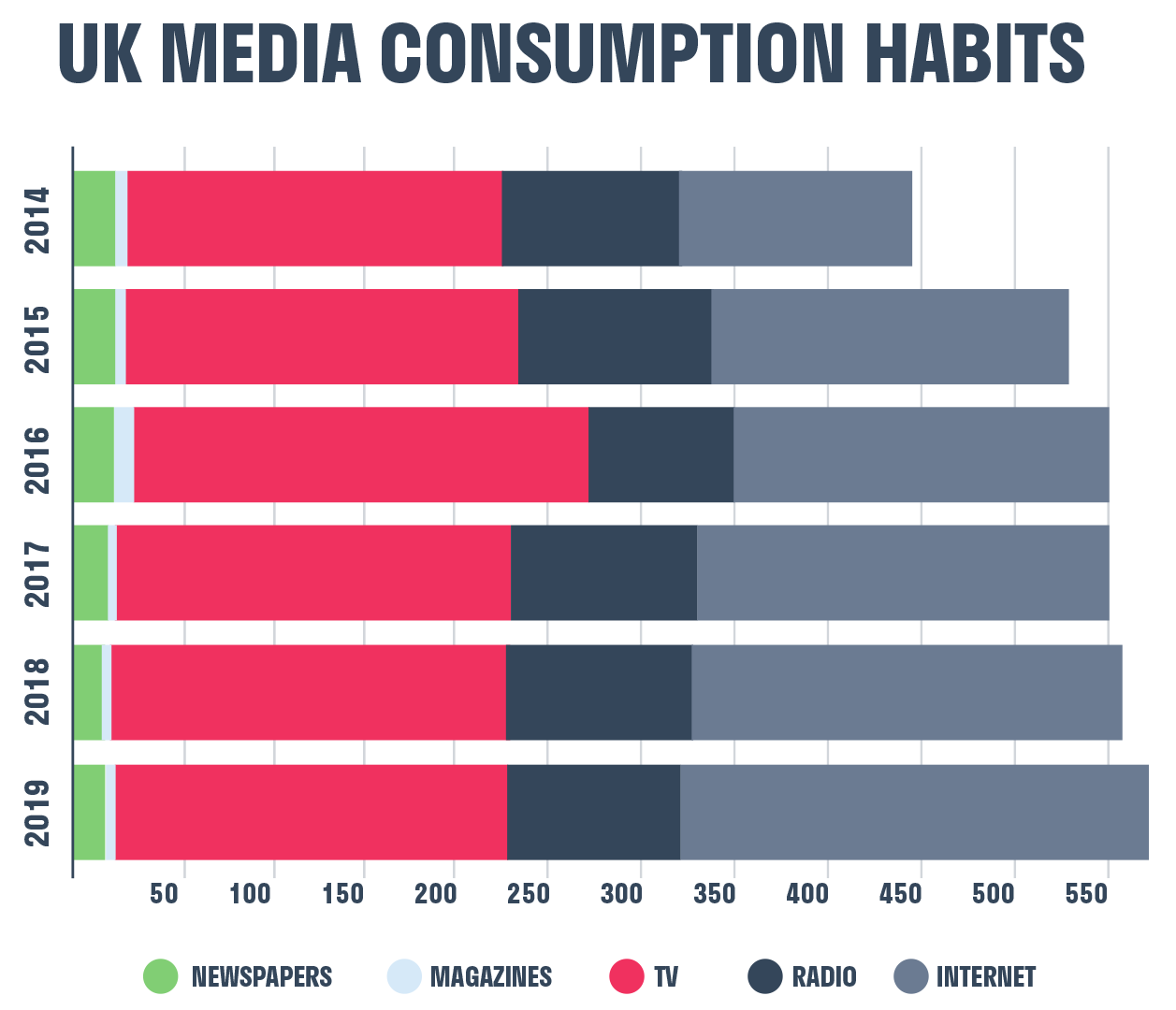
Source: IPA Touchpoints, Zenith
So let’s take a look at each of the most typical forms of traditional marketing and their benefits.
Print media refers to newspapers and magazines. It’s one of the earliest forms of traditional marketing, dating back to the 15th century. In 1440, Johannes Gutenberg invented the printing press, and with that, the production and distribution of news pages en-masse became possible.
Mass production is the type of print media we’re familiar with. However, if you want to take it back even further, evidence of printing techniques have been recorded as early as 3000 B.C.E, in ancient Mesopotamia, where clay tablets were used to imprint symbols and images that elicited meaning. The same technique was used to create one of the most ancient epic stories known to literature, The Epic of Gilgamesh.
 Source: ResearchGate
Source: ResearchGate
But back to the present day. Print newspapers are seeing a decline in ad revenue, and it’s clear to see why; digital advertising is often cheaper and, with impressive algorithms and analytics available at the click of a button, it also offers a lot more in return, such as an extensive reach and the ability to accurately analyse the effect of your hard-earned cash.
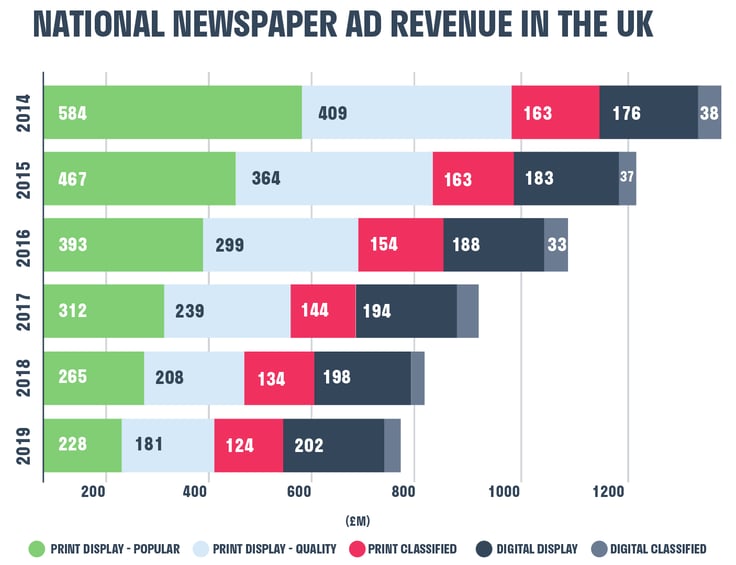
Source: Enders Analysis
That being said, print is most certainly not dead. Many newspapers and magazines are deciding to include digital in their strategies, offering both print media and digital copies of their content. But print alone still has the ability to positively impact your marketing efforts. Research shows that newspaper ads are viewed for 2.5 times longer than the average digital ad. This is because they’re far less in-your-face; people sitting down to read a newspaper or magazine are physically engaging with the product in their hands.
Furthermore, ads in newspapers and magazines are static, meaning that they don’t move around the page and vie for attention - this gives the consumer the power to decide whether or not they wish to engage with this ad.
General Manager for Ebiquity Paris, Nathalie Taboch, has said that people don’t perceive ‘tangible ads (TV, print or poster campaigns) the same way as digital ones’. Digital ads offer instant, snackable content whereas tangible ads call on the imagination thus creating a deeper imprint in the reader’s memory.
Broadcast marketing is the process of utilising television and radio (two well-known classics) for promotion in your marketing strategy in order to increase viewers and listeners. Whilst no one can deny the proliferation of digital marketing, TV, and radio built the foundations of promotion as we know it today, and they’re still a fundamental aspect of many marketing strategies.
That’s partly because television and radio do not exist separately from the online world - sure, people still use regular television sets and radios still reside in kitchens or cars, for example, but they’re also online. Recent studies have shown that that 80% of people still watch programs on a traditional TV set, 35% watch on a laptop, and 29% on a tablet, but that these figures vary by demographic.
That being said, research from Statista shows that the number of TV households increased by 1.83% from 2017 to 2018.
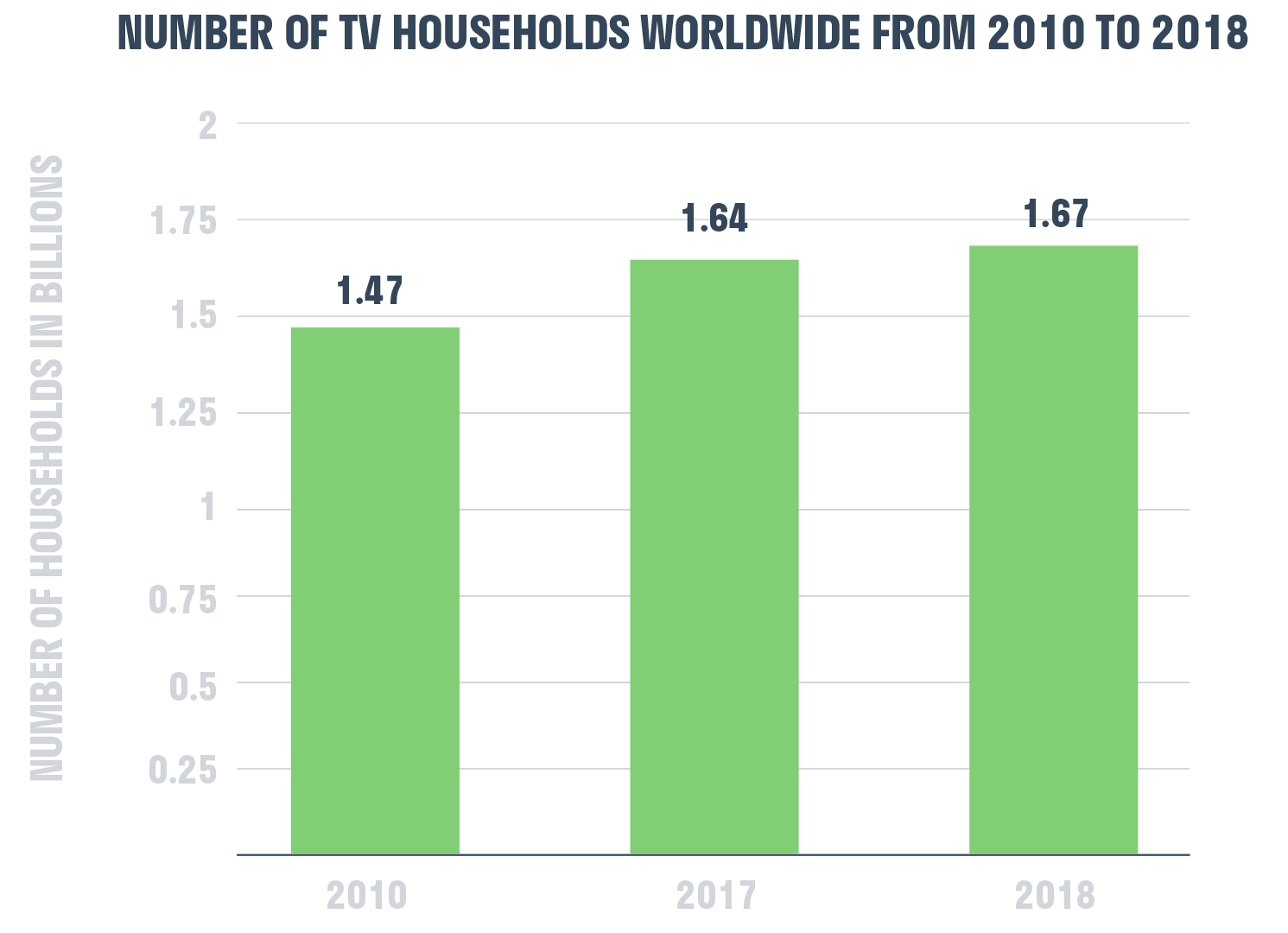
Source: Statista
In order to successfully market using TV and radio, brands often collect and analyse demographic data and corresponding viewing data from their audiences. Similar to any kind of market segmentation research, the data is collected via focus groups, surveys, interviews, etc.
Brands today can still successfully utilise broadcast media in their strategies and see real, valuable results. Unlike many marketing methods, broadcast marketing not only uses traditional promotional techniques like product placement in TV shows and movies, traditional commercials, and endorsements by radio personalities, but it’s breaking into new media venues such as Netflix. Being consistent by maintaining a presence on TV and/or radio, whilst also broadening horizons and branching out into new venues can have a significant impact on the success of brand's endeavours.
As a marketing tactic, direct mail is still widely used. Direct mail doesn’t refer to just one method, it encompasses a variety of materials including postcards, flyers, sales letters, newsletters, and catalogs.
Direct mail is generally targeted as the information is sent to specific individuals or market segments. It lets you communicate your message on a more personal, one-to-one basis and also allows your brand to control who receives the message, as well as when and where they receive it - unlike digital messages, such as email and push notifications, which can be more easily distributed, either accidentally or on purpose, to people who they’re not intended for.
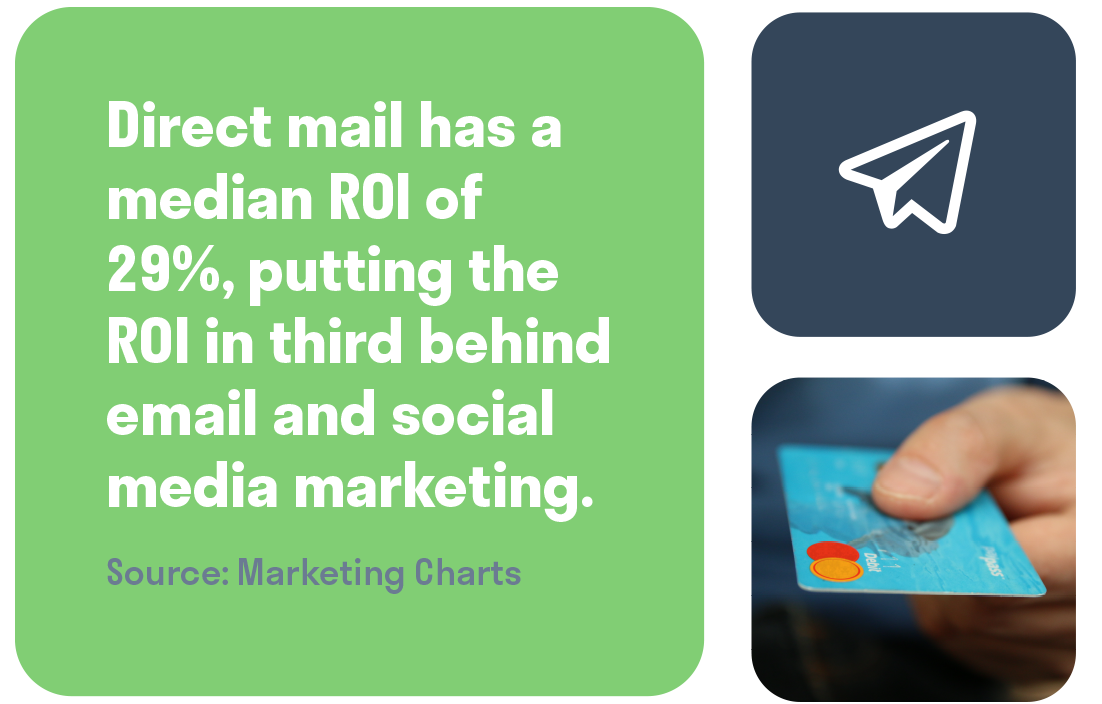
Source: Marketing Charts
That being said, when it comes to direct mail, ‘spam’ is most definitely still a thing - almost all of us will receive a brochure or catalog through our letterboxes that we did not sign up for; have no interest in, and, frankly, the content gets put straight into the recycling box. Not only is this bad for the consumer, who now has to get rid of something they never wanted or considered in the first place, but the money spent by the brand to design, print, and distribute the product has all been for nothing. Additionally, it can be far more difficult to analyse the success of direct mail compared to email, for example.
Nevertheless, with accurate segmentation and targeting, direct mail can be highly personalised, and tailored, and therefore be very valuable, to consumers which, in turn, is beneficial to the brand. It can also greatly increase ROI, brand awareness, and peoples’ affinity towards a brand.
Lastly, we come to referrals. Or 'word of mouth' (WOM) marketing - which we briefly touched on earlier in this article. WOM marketing relies on customers to spread the good word of the brand and its products and services. This could mean a positive comment about a new range of gym shoes, or an artist on Spotify, or it could take the form of User Generated Content (UGC).
Whilst this is essentially free advertising, WOM is a marketing tactic that bears an array of pros and cons.
Known to be one of the most powerful forms of promotion, WOM is considered as being far more effective than traditional media. In fact, 92% of consumers trust recommendations from their friends and family over traditional media. It’s true that people can make referrals of their own accord, but some brands do what’s known as ‘seeding’, where a kind of ‘buzz’ is created and consumers are encouraged or influenced to positively reference a company. This could come out of a promotion, social media campaign, or a celebrity endorsement, for example.
Source: Outbrain
Referral marketing seems great, right? It’s well trusted, it costs practically nothing from a business point of view, however, it should not be solely relied upon. The thing about WOM marketing is you don’t really have much control over it. Sure, you can push out a campaign that speaks highly of your product, and you can put money towards great promotions to spur positive reactions but, at the end of the day, free speech is free speech, and with the unparalleled power of social media and review sites, it would be foolish for a brand to center their entire marketing strategy, and place all of their trust, in referral marketing.
That being said, as social creatures, we naturally share our experiences, especially when it comes to new purchases. So, for example, if a friend recommends a specific brand of hiking boots, you will likely take their recommendation over a TV advert from a large corporation. That’s also one of the reasons why brands are beginning to opt for a human-centered approach to marketing; if you know the brand well enough, as if they were a friend with real purpose, hopes and values, then you will undoubtedly begin to place trust in what they say and do - thus enhancing the cycle of positive referral marketing.
Incorporating marketing automation into your marketing strategy can bring more leads, conversions, and sales, all with less work. According to Marketo, 76% of companies that implement marketing automation generate a return on their investment within the first year. Not only that, but 44% of them see a return within just six months.
Source: Invespcro
There are many great marketing automation platforms out there, and choosing the one that’s right for you will depend on what exactly you want to achieve. But generally speaking, most platforms are designed to help marketers capture leads, develop relationships, and move prospects further down the sales funnel in bulk.
Marketers commonly employ automation for use in their email marketing campaigns, social media scheduling, lead nurturing, multi-channel marketing, and online advertising. Just imagine setting up an automated email marketing campaign whereby all actions are automatically triggered and executed. Now, instead of spending your day manually completing day-to-day tasks, you can focus your energy on driving strategy.
Related reading: How to Boost Your ROI with Email Marketing Automation
By no means does marketing automation turn your brand into a robot. It simply allows you to scale your efforts in order to build relationships with multiple prospects across multiple channels, providing them with high quality, consistent experiences. Plus, with proper segmentation, an automation tool will ensure that you are providing relevant content, to the right prospect, in the right place, and at the right time.
Check out the graphic below to get an overview of the benefits that having a marketing automation strategy in place would bring to your overall business, marketing, and sales team:
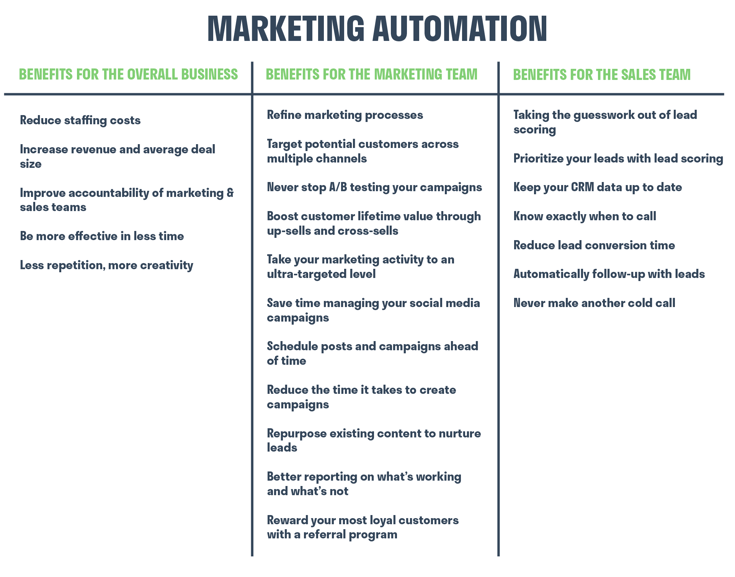
Source: VentureHarbour
With marketing automation, marketers have found easy ways to carry out repetitive tasks. However, the introduction of machine learning and artificial intelligence (AI) has taken this to a whole new level thanks to predictive analytics and personalisation engines. With AI, marketing automation is now more human.
Machine learning involves algorithms that can leverage data to make decisions for itself, as well as being able to continually learn without any human input and adjust actions based on that learning. How smart it becomes depends largely on the amount of data the machine is provided. Here are a few examples of where AI can be applied effectively in marketing:
With marketing tools that support AI in place, you can get even more out of your automation strategy and help to shorten the entire sales cycle as you motivate your target audience to take the desired action sooner. An AI-enabled marketer can reach every customer at the right time, knows the best audience for every campaign, and delivers the perfect content for every customer.

After a long and arduous journey, you have reached the peak of marketing strategy - the sale. You have followed each step to the letter and guess what, it’s worked! You’ve bagged a customer- actually, it's more than likely that you’ve bagged many customers (go you). But your story doesn’t end here!
The biggest mistake that you can make as a marketer is believing that the point of sale is the end of your relationship with a customer. In fact, the sale is just the beginning… Play your cards right and you could nurture one sale into a life-long, loyal, and profitable, brand-customer relationship.
It’s time to think about your customer retention strategy...
Customer retention is a process of dedicating resources to ensure first-time customers return to your business to make repeat purchases, continue their subscription, upgrade their service package, etc.
The ability of a company to retain its customers is measured over a predetermined period of time, i.e. monthly, quarterly, yearly, etc. Depending on what industry you operate within and the goods or services you offer, the tactics which your business deploys to retain customers will be different.
Ultimately, the goal of customer retention is to maximise the lifetime value and profitability of each customer.
If, as a business, you’re totally new to the concept of customer retention, then the first step you need to take is to calculate your current customer retention rate. Now, this does require a small level of mathematical calculation… But never fear, there’s no need for you to be a whiz kid - it’s fairly simple and you’re always allowed to use a calculator to help you! Phew...
To calculate your current retention rate, first pick a time period which you will define retention by. Then, follow the formula below:

This is not the only metric that you should be tracking, however; when it comes to customer retention, there are 2 more key metrics which you need to pay attention to, especially if you’re working in retail or e-commerce industries.
# of Orders Placed / # Unique Customers
2. Average Order Value: determine how much money customers are spending in your store per transaction
Total Revenue Earned / # Orders Placed
Source: Brightback
The level of customer retention activity your business performs will vary depending on where your business is in its lifecycle. For example, a brand new company with no current customers will be 100% focused on their acquisition strategy, but as they begin to gain traction and win customers it would be foolish not to optimise their strategy - and their budget - toward retention.
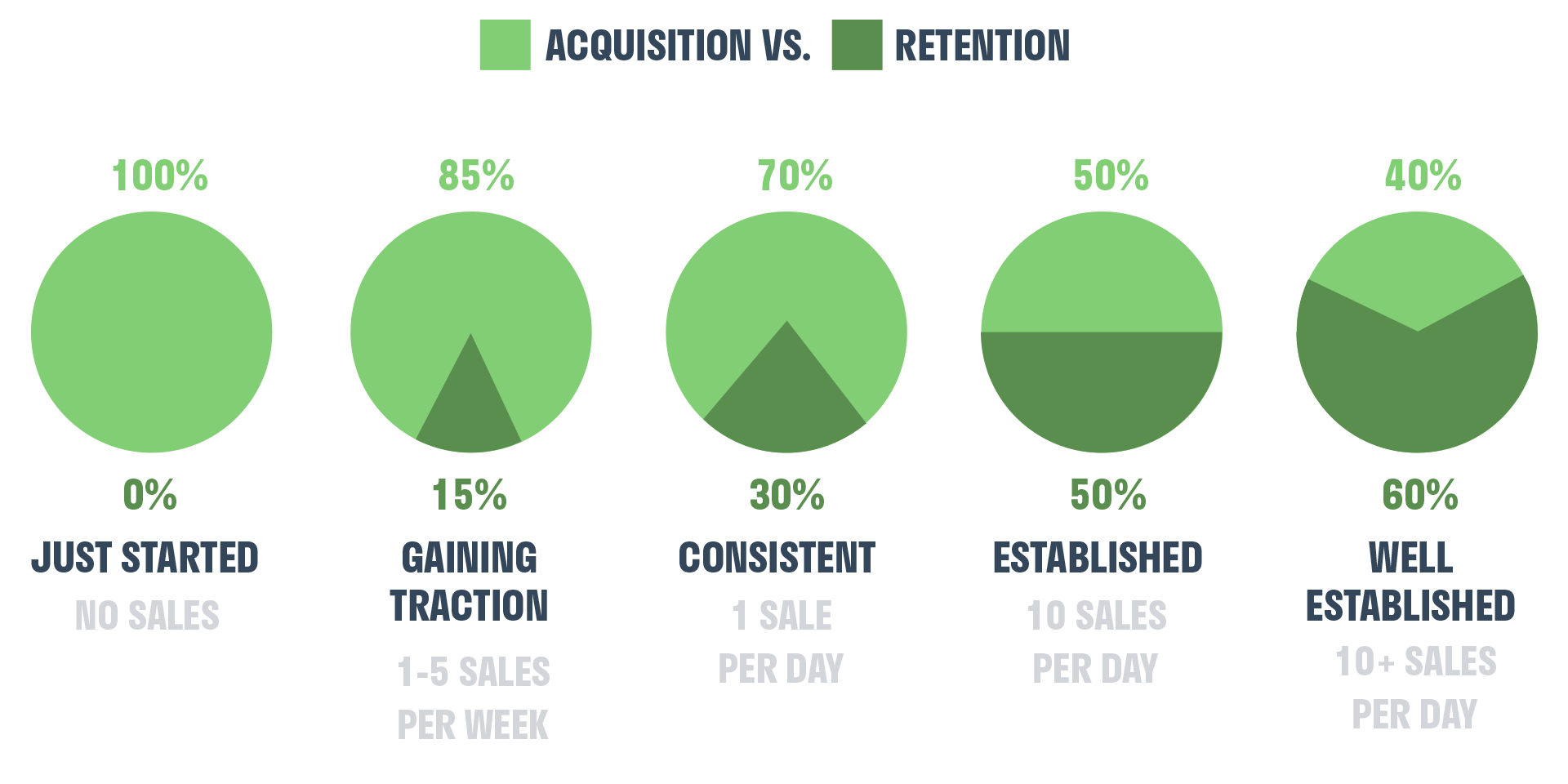
Source: Shopify
There are 3 main reasons why retention is an important factor for any business with customers:
On day one in business school, you learn that it’s cheaper to retain an existing customer than gain a new one - in fact, in some industries, it can cost up to 30 times more to acquire a new customer.
Customer acquisition is expensive and competitive; you have to spend a lot of money to even get your products in front of your customers. For example, Facebook digital advertising costs $0.97 CPC (Cost-Per-Click), and $7.19 CPM (Cost-Per-1000-Impressions).
Pure and simple, focusing time and effort on your customer retention strategy will use your budget more efficiently and effectively.
It’s commonly cited that even a 5% increase in retention rates can increase the profitability of your company by 25% to 95%. With those kinds of numbers, you really can’t afford to ignore retention tactics any longer.
There are several reasons why returning customers drive profitability:
A big focus of your retention activities will be creating an enjoyable experience for your customer. Each touchpoint they have with your business should be easy, from when they first browse your website or store to when they make a purchase, then during onboarding and beyond.
Related reading: 6 Reasons Why Your Business Needs Customer Onboarding
Enjoyable experiences are important to customer retention for two reasons, the first being obvious: they make your customers want to return to your business for repeat purchases. The second reason is more nuanced; enjoyable experiences create emotional connections, they make us happy, loyal, and, well… chatty with our friends and family. This is great in terms of WOM, as SDL reports that 58% of consumers who experience a consistent and positive brand experience share it on social media.
As of May 2018, all marketing communications need to comply with GDPR (General Data Protection Regulation). This means that you can no longer freely collect the information of any Tom-Dick-and-Harry that visits (or doesn’t visit) your website and contact them with content that they don’t want or need.
To put it technically: GDPR impacts the way we store, access, record, and control data. Any data collection must be transparent, meaning that the data subjects must be aware that their data is being collected, have open access to view what data is held on them, and remove the data controllers right to it at any time. This focus on data accountability means that data centralisation becomes imperative - no more silos of data on random spreadsheets and lost documents! Unifying all your data on a CRM system is a must to comply with these regulations.
GDPR also restricted the amount of data you can ask any, one user for in order to qualify them as a lead - this is known as data minimisation. The data you collect must be adequate, relevant, and limited to what is necessary.
GDPR was enacted to give consumers back the control of their personal data and the privacy which they felt had been lost. As a result of the publicity surrounding GDPR and the mass scramble felt by brands to bring their practices in line with the regulations, consumers became acutely aware of their new rights. So, flaunting the new GDPR rules will not sit right with customers today and could not only lose their custom but could see you reported and hit with a hefty fine!

The final step after planning and implementing a marketing strategy is to measure its results. In this day and age, we have the huge advantage of having access to a wide variety of customer data and analytics that we can use to analyse marketing strategy performance and assist any future decisions.
Previously, marketers had been taking a shot in the dark. It was simply impossible (unless you point-blank asked) to be sure where any of your leads came from. If you were simultaneously running both a billboard campaign alongside a radio advertisement, it was likely that you would never know which pulled in more leads than the other.
Related reading: How to be a Data-Driven Marketer: 8 Key Steps
However, digital marketing is now ‘the norm’, as well as being one of the quickest ways to reach out to huge numbers of your target market at the same time through the likes of PPC marketing, Google Ads, and various other search engines and social platforms. It’s likely that most of the platforms you use will have tools already built in that allow for easy data capture and analysis. For example, with Google Ads, you get quick access to all marketing analytics such as how many people have seen your ads, clicked on them, visited your website, and even called you. By having a clear overview of how your ads are performing you can tweak or pause them at any time you like.
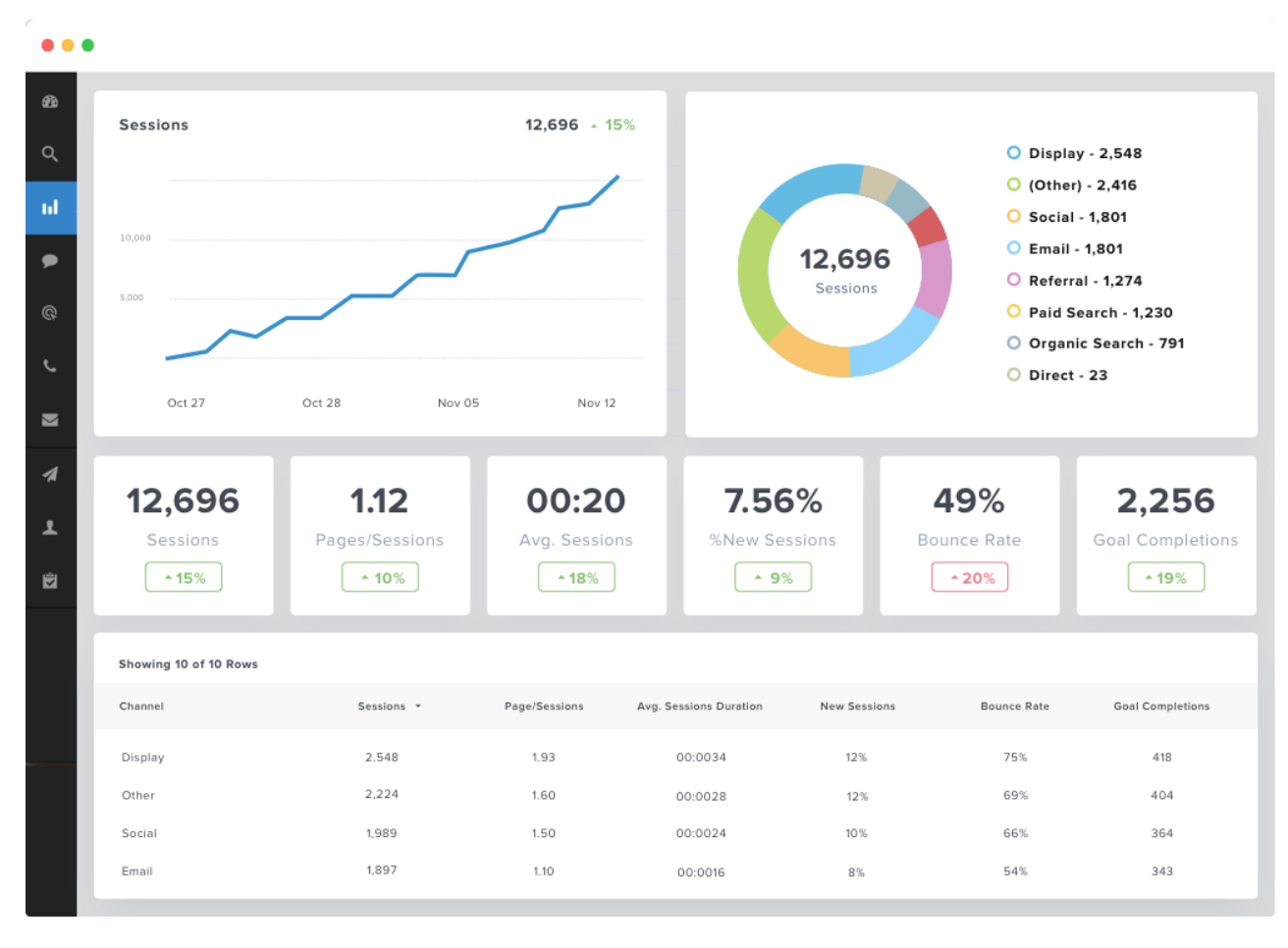
Keeping a close eye on your key performance indicators (KPIs) is an important part of your overall strategy as it allows marketers to be much more efficient and make better use of their marketing budget. Plus, it’s likely that your competitors are already leveraging their marketing analytics to learn and advance their business, so you need to be doing the same to prevent falling behind.
Source: McKinsey & Company
![Big Data for Beginners: Improve Your Marketing Strategy [Read Blog]](https://no-cache.hubspot.com/cta/default/2080894/3e74e831-9f19-406f-992a-27d5a31d73b2.png)
In order to get the most out of your marketing analytics, you need to make sure you choose the right KPIs to measure. Tracking the wrong KPIs won’t drive any actionable results and will only be a huge waste of your time and resources. When it comes to evaluating the success of your marketing strategy you need to choose the KPIs that are most in-line with your business goals.
To get you started, here are 5 KPIs that every marketer should be measuring:
Your number one KPI. This involves whether or not the sales you make are exceeding the cost of your marketing strategy.
How much is it costing you on average to generate one lead as a result of your marketing efforts? For example, if you spend $100 on Google Ads and generate 10 leads, your CPC is $10.
This metric involves tracking all website activity, including how many visitors your website received, where they came from, the pages they viewed, bounce rate, etc.
The true test of your content marketing efforts is by looking at how many leads it generates as a result. How are the forms on your landing pages performing? What is the percentage of reputable MQLs (marketing qualified leads)?
How many leads are you getting from social media networks such as Facebook, Instagram, LinkedIn, Twitter, etc.? What sort of posts generate the most engagement?
These 5 KPIs are just a skim off the surface when it comes to the true potential of marketing analytics. With data behind you, any decision you make as a result has a much higher chance of success in comparison to guesswork. Investing time into your analytics strategy will allow you to prove that your efforts are delivering high-quality leads that convert into sales.
Pulling together a successful marketing strategy plan won’t just happen overnight. There are a number of factors that we have touched on throughout this guide that must be considered. From establishing your target audience, right through to developing strategies for customer retention and marketing strategy analysis, the entire process will require extensive research, planning, patience, creativity, and passion.
As we discussed at the beginning, your marketing strategy should be repeatable, and scalable in order to have the best chances of success. With a company-wide strategy in place, everyone remains on the same page as to the steps that need to be taken to reach the pre-defined goals and objectives of the organisation. As a marketer, you can focus your efforts on ways to improve the strategy and make it work, rather than worry each month about what the strategy is going to be.
A marketing strategy plan will help you to develop an edge over your competitors as it will highlight each and every step you need to take to improve your business. It also provides you with the opportunity to build a tight-knit relationship with your customers, giving you insight into different ways to adapt your product or service to better meet their needs.
Every marketing strategy is different. However, the overall purpose of any great strategy is to map out the steps you're going to take to achieve your desired goals. Put the hard work in and you’ll be well on your way to reaping the rewards.